The State of the Sound
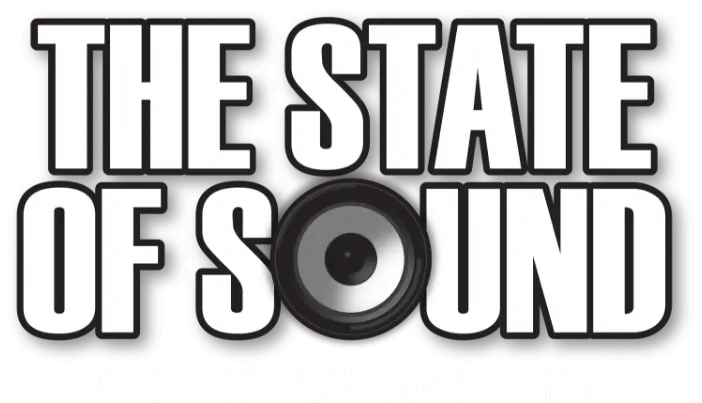
To start your journey: 1) Click on the down arrow 2) Use the scroll bar or 3) Click on the Table of Contents to
view the key topics
![]()
The Spirit of Possibility Moves Us
Generations of musicians have come to Illinois by train, bus, and automobile. The Land of Lincoln has offered the promise of jobs, housing, and a new way of looking at things. Rhythms and lyrics that carried these desires shaped a sound that has a global reach. This community of Illinois music reflects our American diversity: Spiritual and Blues, Country, Soul and Rock, International, and Hip–Hop and House.
This music helps us imagine who we are. And through the boundless energy of our imagination, we can reach our potential. In this beautiful hall in the center of the country, you will discover how the sound of the heartland lives within all of us.
You will celebrate who we can be when we sing a song together.
– Dave Hoekstra
![]()
![]()
![]() Dr. Lena McLin, Chicago, IL, (born in Georgia)
Dr. Lena McLin, Chicago, IL, (born in Georgia)
Dr. Lena McLin, Chicago, IL, (born in Georgia)
Gospel
Sound of Higher Ground
The sonic description of Gospel music is a harvest of all that comes from the heart: love, pain, memory and hope. The voice is the vessel to deliver the news. The voice can be solo or it can shape rainbows in a choir. Like a centerpiece on a table, this declaration is surrounded by instrumentation that ranges from an earth-shaking guitar to a cresting organ.
![]()
![]() Thomas A. Dorsey, Chicago, IL, (born in Georgia)
Thomas A. Dorsey, Chicago, IL, (born in Georgia)
Thomas A. Dorsey, Chicago, IL, (born in Georgia)
Gospel
Chicago is the birthplace of American gospel. Chicagoan Thomas A. Dorsey – “The Father of Gospel Music” – wrote songs that touched Dr. Martin Luther King and Elvis Presley. Chicago’s Soul Stirrers illustrated the bridge between gospel and soul music with young members like Sam Cooke, Lou Rawls, and Johnnie Taylor. The Gospel spirit traveled into Chicago area homes from 1963 to 1984 through the popular Jubilee Showcase television show.
![]()
![]() Mahalia Jackson, Chicago, IL, (born in Louisiana)
Mahalia Jackson, Chicago, IL, (born in Louisiana)
Mahalia Jackson, Chicago, IL, (born in Louisiana)
Gospel
The Gospel sound is precious and timeless. It bends notes and walks the mainline. The most deliberate hymn contains a wide range of expression. All Gospel music contains unparalleled devotion.
It celebrates the purity of the soul.
![]()
![]()
Gospel
Mahalia Jackson 1957 Performance Contract
By 1957, Mahalia Jackson stood at the pinnacle of her career as the country’s top gospel singer and was now on Columbia Records. This contract to perform at New York City’s prestigious Town Hall in 1957 provides a glimpse into Jackson’s famed business acumen, as she notes to increase her performance fees.
Courtesy of Robert M. Marovich
![]()
![]()
Gospel
Curtis Mayfield Performance Music Score of "It’s Alright"
Curtis Mayfield regularly included his 1963 Impressions hit, "It’s Alright," in his live shows. This is a marked-up performance "Rhythm" score for the song, which has been covered by Etta James, Phil Collins, Huey Lewis, Bruce Springsteen, and was recently featured in the Disney movie Soul.
Courtesy of the Curtis Mayfield Estate
![]()
-
![]() Albertina Walker and the Caravans, Chicago, IL
Albertina Walker and the Caravans, Chicago, IL
-
![]() Barrett Sisters, Chicago, IL
Barrett Sisters, Chicago, IL
-
![]() Curtis Mayfield, Chicago, IL
Curtis Mayfield, Chicago, IL
-
![]() Highway Q.C.'s, Chicago, IL
Highway Q.C.'s, Chicago, IL
-
![]() James Cleveland, Chicago, IL
James Cleveland, Chicago, IL
-
![]() The Emmy® award-winning gospel TV series "Jubilee Showcase"
The Emmy® award-winning gospel TV series "Jubilee Showcase"
-
![]() Mahalia Jackson's album God's Gonna Separate the Wheat From the Tares, 1937
Mahalia Jackson's album God's Gonna Separate the Wheat From the Tares, 1937
-
![]() Oscar Brown Jr, Chicago, IL
Oscar Brown Jr, Chicago, IL
-
![]() Reverend Milton Brunson, Chicago, IL
Reverend Milton Brunson, Chicago, IL
-
![]() Roberta Martin, Chicago, IL, (born in Arkansas)
Roberta Martin, Chicago, IL, (born in Arkansas)
-
![]() Sallie Martin, Chicago, IL, (born in Georgia)
Sallie Martin, Chicago, IL, (born in Georgia)
-
![]() Staple Singers, Chicago, IL
Staple Singers, Chicago, IL
-
![]() Staple Singers single "Sit Down Servant," 1963
Staple Singers single "Sit Down Servant," 1963
-
![]() Staple Singers in concert at the Petrillo Bandshell, Chicago, IL, 1986
Staple Singers in concert at the Petrillo Bandshell, Chicago, IL, 1986
-
![]() The Soul Stirrers, formed in Texas, moved to Chicago
The Soul Stirrers, formed in Texas, moved to Chicago
-
![]() Thomas Dorsey Playing Piano
Thomas Dorsey Playing Piano
![]()
![]()
![]() Muddy Waters, Chicago, IL, (born in Mississippi)
Muddy Waters, Chicago, IL, (born in Mississippi)
Muddy Waters, Chicago, IL, (born in Mississippi)
The Blues
The Blues Grew into its Wings in Illinois
The blues are a sparrow that flew north over the Mississippi River and landed in Illinois.
Out of the nest came the electricity of Muddy Waters and the haunting call of Howlin’ Wolf. Waters (McKinley Morganfield) carried the muscle of Mother Earth while Wolf (Chester Burnett) was possessed by a wicked bolt of “Smokestack Lightning.”
The Rolling Stones took their name from the 1950 Muddy Waters song Rollin’ Stone. Sun Records founder Sam Phillips said Howlin’ Wolf’s vocals contained all the raw beauty he thought about in one man. And Sam recorded Elvis Presley. Scores of rock musicians embraced the raw attitude and emotion of the blues.
![]()
![]() Willie Dixon, Chicago, IL, (born in Mississippi)
Willie Dixon, Chicago, IL, (born in Mississippi)
Willie Dixon, Chicago, IL, (born in Mississippi)
The Blues
Chicago bandleader, songwriter, and bassist Willie Dixon dispatched his profound rhythms across the world. Dixon’s sound was a passport to rock n’ roll. Led Zeppelin never would have had “Whole Lotta Love” without Dixon’s “You Need Love.” Dixon was also an early architect at Chess Records before flying off to Chicago’s Cobra Records in the late 1950s where he produced nascent tracks for Buddy Guy, Otis Rush, and Magic Sam.
![]()
![]() Howlin' Wolf, Chicago, IL, (born in Mississippi) and his 1954 Chess record Rockin’ Daddy
Howlin' Wolf, Chicago, IL, (born in Mississippi) and his 1954 Chess record Rockin’ Daddy
Howlin' Wolf, Chicago, IL, (born in Mississippi) and his 1954 Chess record Rockin’ Daddy
The Blues
Leonard and Phil Chess opened Chess in 1950 on the south side of Chicago. The brothers tested their earliest records by blaring them out at a bus stop. In a short 25 years, artists like Chuck Berry, Bo Diddley, Etta James, Howlin' Wolf, and the Rolling Stones heard the call and recorded at Chess.
![]()
![]()
The Blues
Howlin’ Wolf’s Harmonica
Howlin’ Wolf was an enigmatic singer, guitarist, and harmonica player. His most famous song, “Smokestack Lightin’,” has a memorable harmonica solo in the middle. This is Wolf’s 1950s-era Marine Band harmonica. It is in the Key of A major, a traditional key for Blues and Rock.
Courtesy of Bettye Kelly
![]()
![]() Buddy Guy, Chicago, IL, (born in Louisiana)
Buddy Guy, Chicago, IL, (born in Louisiana)
Buddy Guy, Chicago, IL, (born in Louisiana)
The Blues
Buddy Guy
Buddy Guy’s electricity and business acumen delivered the blues to a new generation while the Chicago-based record labels Alligator and Delmark Records preserved the blues for the future. The earliest recordings of boogie guitarist Hound Dog Taylor at Alligator (1971) and nine-string guitarist Big Joe Williams (in 1961) at Delmark kept the blues pumping through the advent of pop and rock music.
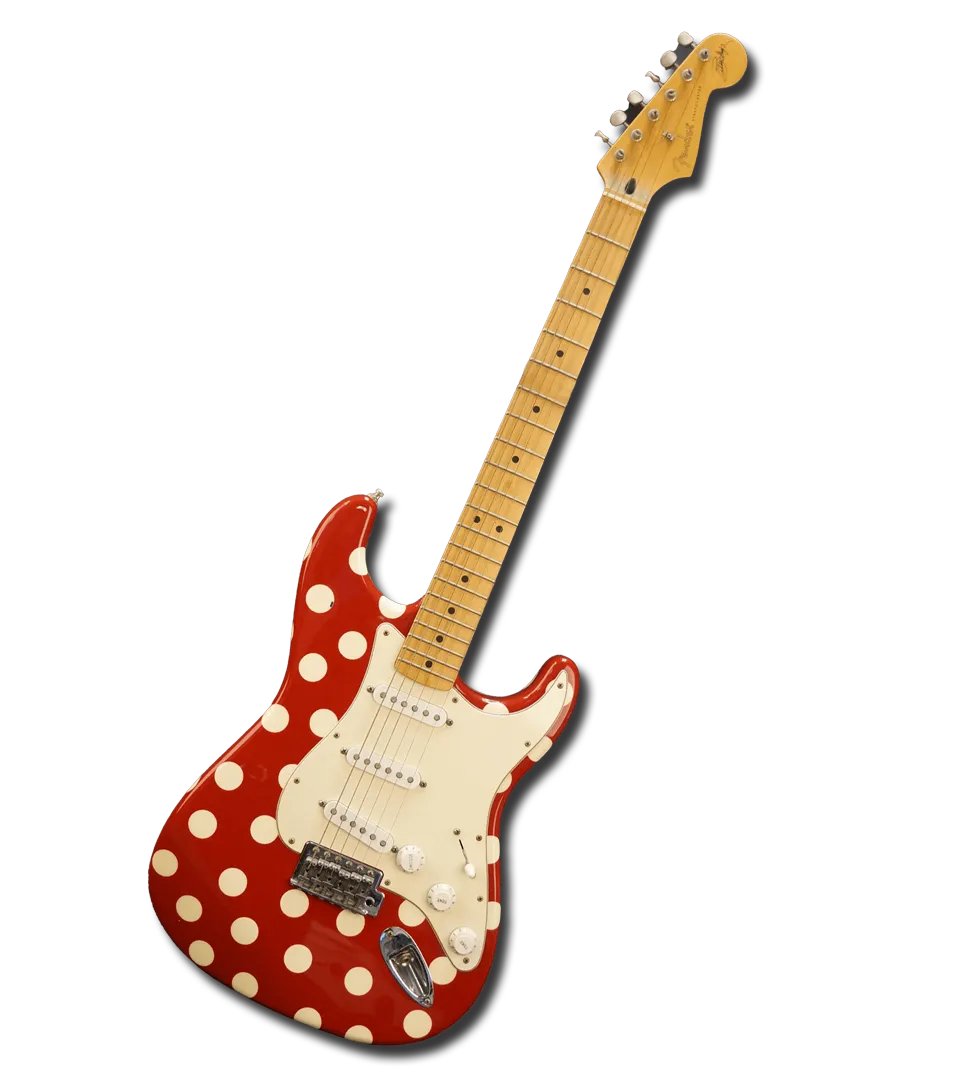
![]()
The Blues
Fender Stratocaster Guitar Owned and Played by Buddy Guy
Buddy Guy’s electricity and business acumen delivered the blues to a new generation while the Chicago-based record labels Alligator and Delmark Records preserved the blues for the future. The earliest recordings of boogie guitarist Hound Dog Taylor at Alligator (1971) and nine-string guitarist Big Joe Williams (in 1961) at Delmark kept the blues pumping through the advent of pop and rock music.
Courtesy of Buddy Guy’s Legends

![]()
![]() Junior Wells, Chicago, IL, (born in Tennessee)
Junior Wells, Chicago, IL, (born in Tennessee)
Junior Wells, Chicago, IL, (born in Tennessee)
The Blues
The blues reached new heights through the hummingbird harmonicas of Junior Wells, a compatriot of Buddy Guy and Paul Butterfield, a southside Chicago native. The Paul Butterfield Blues Band meshed electric blues with rock and jazz. This progression was not lost on Bob Dylan who recruited the Paul Butterfield Blues Band for his first electric performance at the 1965 Newport Folk Festival. Dylan’s traditionalists were upset. Traditions have continued to be redefined by modern-day Chicago blues artists like guitarist Toronzo Cannon, the soulful Lurrie Bell, and harmonica player Billy Branch.
![]()
![]() Koko Taylor, Chicago, IL, (born in Tennessee)
Koko Taylor, Chicago, IL, (born in Tennessee)
Koko Taylor, Chicago, IL, (born in Tennessee)
The Blues
The timeless “Wang Dang Doodle” was written by Willie Dixon, but the late Koko Taylor made it her own and opened the door for countless female blues artists. The torch is proudly carried today by contemporary blues singers such as Alligator’s Shemika Copeland who was bequeathed the title “Queen of the Blues” by Koko’s daughter. The blues arguably were born in the South. But this historic 20th-century migration reminds us that the blues were liberated in Chicago.
![]()
![]()
The Blues
Handwritten Lyrics for “I’m Wanted All Over the World” by Willie Dixon
Willie Dixon wrote the song “I’m Wanted All Over the World” for his 1971 Yambo Records album Peace? It has been covered many times, most famously by George Thorogood and the Destroyers in 1980. These lyrics are in Willie’s hand.
Courtesy of the Alex Dixon and the Willie Dixon Family
![]()
![]()
The Blues
Howlin’ Wolf’s Gun License
Howlin’ Wolf (Chester Burnett) had a big striking voice and was also an imposing figure at 6 foot 3. He carried a firearm for protection, for which he needed this 1960s-era firearms license.
Courtesy of Bettye Kelly
![]()
-
![]() Buddy Guy and Junior Wells
Buddy Guy and Junior Wells
-
![]() Koko Taylor and Willie Dixon perform in Chicago, 1987
Koko Taylor and Willie Dixon perform in Chicago, 1987
-
![]() Koko Taylor, Chicago, IL, (born in Tennessee)
Koko Taylor, Chicago, IL, (born in Tennessee)
-
![]() Jonny Lang, Buddy Guy, and Ronnie Wood at Crossroads Guitar Festival, 2010
Jonny Lang, Buddy Guy, and Ronnie Wood at Crossroads Guitar Festival, 2010
-
![]() Little Walter, Chicago, IL, (born in Louisiana)
Little Walter, Chicago, IL, (born in Louisiana)
-
![]() Luther Allison and Otis Rush, Chicago Blues Festival, 1995
Luther Allison and Otis Rush, Chicago Blues Festival, 1995
-
![]() Magic Sam, Chicago, IL, (born in Mississippi)
Magic Sam, Chicago, IL, (born in Mississippi)
-
![]() Muddy Waters, Chicago, IL, (born in Mississippi)
Muddy Waters, Chicago, IL, (born in Mississippi)
-
![]() Otis Clay, Chicago, IL, (born in Mississippi)
Otis Clay, Chicago, IL, (born in Mississippi)
-
![]() Paul Butterfield, Chicago, IL
Paul Butterfield, Chicago, IL
-
![]() Shemekia Copeland, Chicago, IL, (born in New York)
Shemekia Copeland, Chicago, IL, (born in New York)
![]()
![]() Sam Cooke, Chicago, IL, (born in Mississippi)
Sam Cooke, Chicago, IL, (born in Mississippi)
Sam Cooke, Chicago, IL, (born in Mississippi)
Soul and R&B
The Heavenly Sound of Illinois Soul and R&B
Some of Soul music’s mightiest figures came from the church: Sam Cooke, Curtis Mayfield, Lou Rawls, Donny Hathaway, Otis Clay, and the Staple Singers in Chicago. The Rev. Al Green in Memphis, the Isley Brothers in Cincinnati, and Marvin Gaye in Detroit.
![]()
![]() Staple Singers, Chicago, IL
Staple Singers, Chicago, IL
Staple Singers, Chicago, IL
Soul and R&B
Controversy sometimes occurred when artists crossed over
Controversy sometimes occurred when artists crossed over from the church to apply religious lessons in secular music but the music remained filled with clarity and dignity. It played well in the mist of the morning but just as well as under the sheets of a candlelit bedtime.
![]()
![]() Curtis Mayfield, Chicago, IL
Curtis Mayfield, Chicago, IL
Curtis Mayfield, Chicago, IL
Soul and R&B
Curtis Mayfield
And there were lessons to be learned by listening to Mayfield’s bountiful songbook (“People Get Ready," “This is My Country,” “Keep on Pushing"), the Five Stairsteps timeless “O-o-h Child” and Hathaway’s “The Ghetto.”
![]()
![]() Chaka Khan, the “Queen of Funk,” Chicago, IL
Chaka Khan, the “Queen of Funk,” Chicago, IL
Chaka Khan, the “Queen of Funk,” Chicago, IL
Soul and R&B
When it came time to dance, Rhythm and Blues (R&B) took the stage.
When it came time to dance, Rhythm and Blues (R&B) took the stage. Rhythm and Blues were created as it sounds: a Funk bottom establishing the rhythm, a shot of Blues for the emotional measure, and later some electronic Disco for the party.
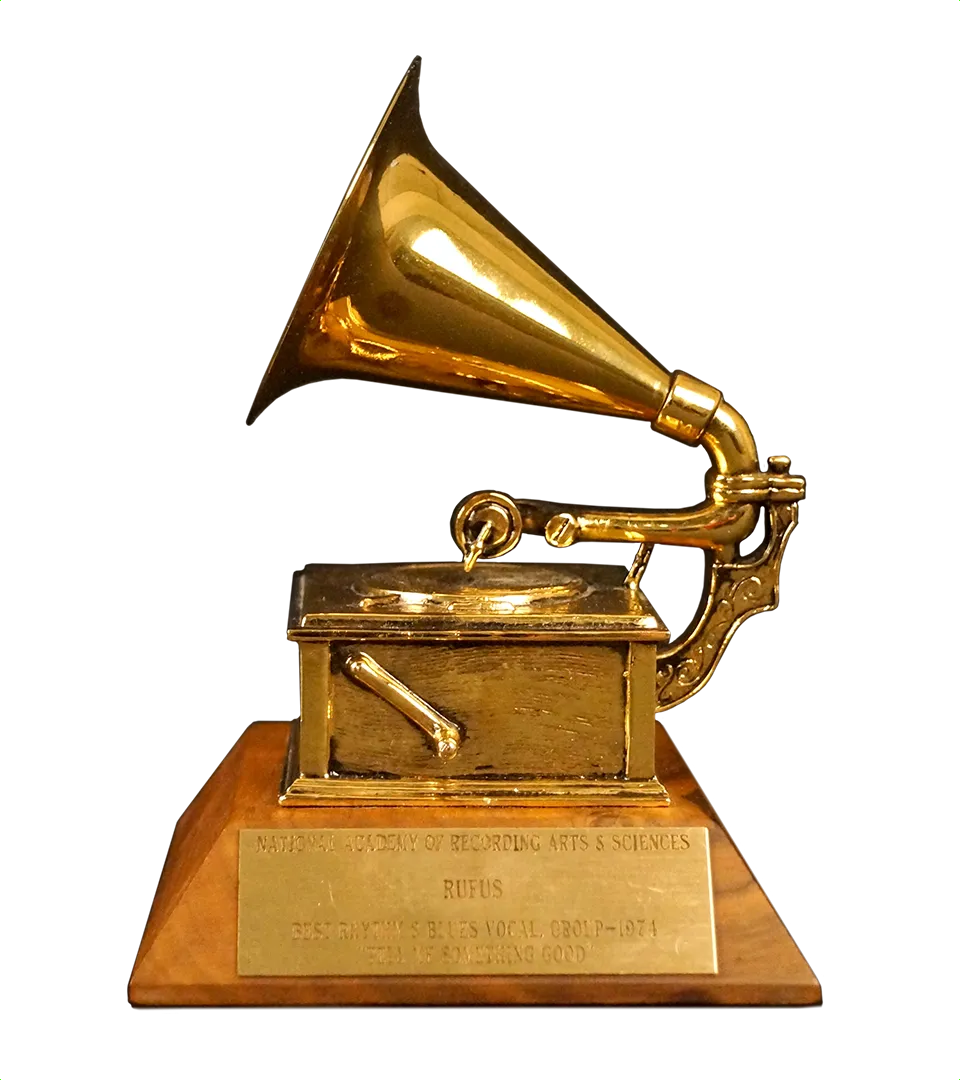
![]()
Soul and R&B
Grammy Award for “Tell Me Something Good” by Rufus
The 1974 song “Tell Me Something Good” was written by Stevie Wonder and Rufus frontwoman Chaka Khan. It won the 1975 Grammy Award for Best R&B Vocal Performance by a Duo, Group, or Chorus. Rufus member Ron Stockert (keyboards and vocals) received the award.
Courtesy of Bruce Horn

![]()
![]() Tyrone Davis, Chicago, IL, (born in Mississippi)
Tyrone Davis, Chicago, IL, (born in Mississippi)
Tyrone Davis, Chicago, IL, (born in Mississippi)
Soul and R&B
The gritty sound of Illinois Rhythm and Blues stretched from Tyrone “The Wonder Boy” Davis (“Turn Back the Hands of Time”) in Chicago to Ike and Tina Turner emerging from East St. Louis (Il.) and St. Louis. Rhythm and Blues expanded on the faith of Soul music by adding spectral group vocals, fiery horns, and a sense of artistic anarchy that was open to Rock music, modern Jazz, and later Hip-Hop.
![]()
![]()
Soul and R&B
Portrait of Jennifer Hudson as Aretha Franklin from Respect Movie, Created by Alexa Holland
Academy- and Grammy Award-winner Jennifer Hudson stars and sings in the 2021 biopic of Queen of Soul Aretha Franklin, Respect. Alexa Holland created this digital portrait of Hudson as Franklin for use in the film.
Courtesy of Jennifer Hudson
![]()
![]()
Soul and R&B
Curtis Mayfield Grammy Nomination Plaque for Super Fly
Enigmatic singer and guitarist Curtis Mayfield, known as the Gentle Genius, wrote and recorded songs for the landmark soundtrack to the 1972 movie Super Fly. He received a Grammy nomination for the album and the song “Freddie’s Dead.”
Courtesy of the Curtis Mayfield Estate
![]()
-
![]() Five Stairsteps, Chicago, IL
Five Stairsteps, Chicago, IL
-
![]() Jerry Butler & The Impressions, Chicago, IL
Jerry Butler & The Impressions, Chicago, IL
-
![]() Donny Hathaway, Chicago, IL
Donny Hathaway, Chicago, IL
-
![]() Earth, Wind & Fire, Chicago, IL
Earth, Wind & Fire, Chicago, IL
-
![]() Jennifer Hudson, Chicago, IL
Jennifer Hudson, Chicago, IL
-
![]() Jerry Butler, Chicago, IL, (born in Mississippi)
Jerry Butler, Chicago, IL, (born in Mississippi)
-
![]() Lou Rawls, Chicago, IL
Lou Rawls, Chicago, IL
-
![]() Minnie Riperton, Chicago, IL
Minnie Riperton, Chicago, IL
-
![]() Oscar Brown, Jr, Chicago, IL
Oscar Brown, Jr, Chicago, IL
-
![]() Terry Collier, Chicago, IL
Terry Collier, Chicago, IL
-
![]() Tyrone Davis, Chicago, IL, (born in Mississippi)
Tyrone Davis, Chicago, IL, (born in Mississippi)
![]()
![]() Louis Armstrong, Chicago, IL, (born in Louisiana)
Louis Armstrong, Chicago, IL, (born in Louisiana)
Louis Armstrong, Chicago, IL, (born in Louisiana)
Jazz
Freedom of Jazz rooted in Illinois
The origins of Jazz are heard in Louis Armstrong, who brought his emancipating sound to Chicago from New Orleans in 1922. Armstrong’s free-spirited phrasing on the coronet/trumpet and tight combination of melody and rhythm allowed him to become the first Jazz soloist. Generations heard adventure in his improvisation, extending from horn to scat-oriented vocals.
Everyone else followed.
In their own very distinct style.
![]()
![]()
Jazz
The Louis Armstrong Story Vol. 1 33rpm LP Record by Louis Armstrong and His Hot 5
Released in 1956, this mono recorded compilation album by Columbia Records captured the Jazz legend’s early 1920s sound, when he lived, performed, and recorded these songs in Chicago.
Abraham Lincoln Presidential Library and Museum
![]()
![]() Benny Goodman, third from left, with his band in 1952
Benny Goodman, third from left, with his band in 1952
Benny Goodman, third from left, with his band in 1952
Jazz
Benny Goodman was a famous American jazz clarinetist and bandleader, known as the “King of Swing.” He was born in Chicago in 1909 to Jewish immigrants from Russia. He learned to play the clarinet at a young age and soon became a professional musician, playing in various bands and clubs in Chicago. He was influenced by New Orleans jazz musicians such as Jimmie Noone and Louis Armstrong. He moved to New York in 1929 and formed his own band in 1934.
![]()
![]()
Jazz
Clarinet and Cleaning Cloth Owned by Benny Goodman
Benny Goodman singlehandedly made the clarinet cool. He was the premier Jazz bandleader of his era.
Courtesy of Benjie Lasseau, daughter of Benny Goodman
![]()
![]() Miles Davis, Alton, IL
Miles Davis, Alton, IL
Miles Davis, Alton, IL
Jazz
Trumpet player-composer Miles Davis was the birth of cool. He wrapped the free-flowing tones of his Martin Committee trumpet into a bouquet for the world. Davis was born in 1926 on a clarion call out of Alton, IL, and raised in East St. Louis. By 1944, he had joined saxophonist Charlie Parker’s quartet in New York City. Davis died in 1991 of a stroke and respiratory failure. He is buried with a black Martin Committee trumpet in Woodlawn Cemetery in the Bronx, NY.
![]()
![]()
Jazz
This Martin Committee red custom trumpet and mouthpiece was made for jazz legend Miles Davis and he used it for concert performances throughout the 1980s which turned out to be the last phase of his nearly 50-year career. The iconic jazz empresario recorded and release seven records during this experimental period.
Courtesy of Miles Davis Properties, LLC
![]()
![]() Herbie Hancock, Chicago, IL
Herbie Hancock, Chicago, IL
Herbie Hancock, Chicago, IL
Jazz
Herbie Hancock
Chicago-born keyboardist Herbie Hancock has taken jazz to worlds that Louis Armstrong might never have imagined. His six-decade career defies classification. Between 1963 and 1968 Hancock was a member of the second Miles Davis Quintet and later used a pastiche of fusion, funk, and electronics for crossover hits like 1973’s “Chameleon” and 1983 DJ scratch hit “Rockit.” Hancock guested on Fender Rhodes on Stevie Wonder’s “As” as one of the hallmark tracks on 1976’s “Songs in the Key of Life.” Hancock’s 2010 “Imagine Project” included collaborations with Jeff Beck, fellow Chicagoan Chaka Khan, Los Lobos, and others.
Hancock’s sonic crusades remind us that jazz is full of possibilities. Just like America itself.
![]()
![]()
Jazz
Jacket Worn by Herbie Hancock in Round Midnight
Jazz mastermind Herbie Hancock’s nearly six-decade career has defied classification. Hancock wore this jacket in the 1986 film, Round Midnight, in which he played Eddie Wayne. Hancock also won a Best Original Score Academy Award for the film.
Courtesy of Herbie Hancock
![]()
-
![]() Gene Krupa, Chicago, IL
Gene Krupa, Chicago, IL
-
![]() Herbie Hancock, Chicago, IL
Herbie Hancock, Chicago, IL
-
![]() Joseph Nathan "King" Oliver, Chicago, IL, (born in Louisiana)
Joseph Nathan "King" Oliver, Chicago, IL, (born in Louisiana)
-
![]() Kurt Elling, Chicago, IL
Kurt Elling, Chicago, IL
-
![]() Lee Konitz, Chicago, IL
Lee Konitz, Chicago, IL
-
![]() Lionel Hampton, Chicago, IL, (born in Kentucky)
Lionel Hampton, Chicago, IL, (born in Kentucky)
-
![]() Louis Armstrong, Chicago, IL, (born in Louisiana)
Louis Armstrong, Chicago, IL, (born in Louisiana)
-
![]() Miles Davis, Alton, IL
Miles Davis, Alton, IL
-
![]() Ramsey Lewis, Chicago, IL
Ramsey Lewis, Chicago, IL
-
![]() The Green Mill Cocktail Lounge, established in 1934 in Chicago, IL
The Green Mill Cocktail Lounge, established in 1934 in Chicago, IL
![]()
![]() Andrew Bird, Lake Forest, IL
Andrew Bird, Lake Forest, IL
Andrew Bird, Lake Forest, IL
Folk
The Common Good of Illinois Folk music
From its humanitarian base, Illinois folk music is a hybrid of banjo, fiddle, guitar, harmonica, ukulele, poetry – and more. The sound is a fertile product of its environment, keeping loyal to cultural identity. It has been said that if it was never new and it never gets old, then it is a Folk song. There is no regard for style or fashion.
![]()
![]() Steve Goodman, Chicago, IL
Steve Goodman, Chicago, IL
Steve Goodman, Chicago, IL
Folk
Illinois singer-songwriters like Steve Goodman, John Prine, and Andrew Bird found the welcome urban landscape of Chicago a fertile ground for their music. Chicago is America’s biggest small town.
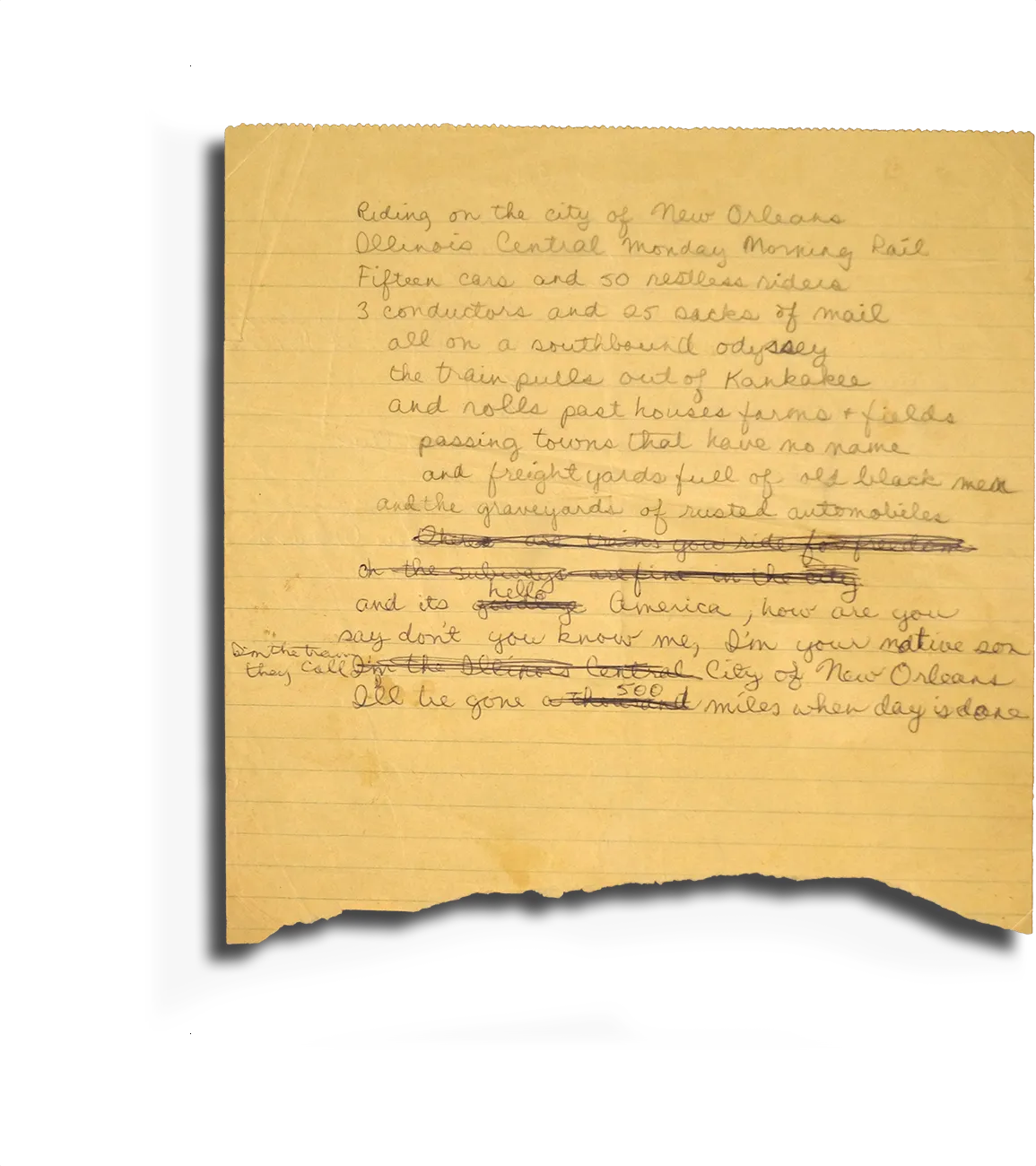
![]()
Folk
Handwritten Lyrics of “City of New Orleans” by Steve Goodman
Originally featured on Steve Goodman’s self-titled debut in 1971, “The City of New Orleans” is arguably his most famous and enduring song. Both Arlo Guthrie and Willie Nelson recorded hit versions. Nelson’s cover won a Grammy in 1984 for Best Country Song following Goodman’s death.
Courtesy of Rosanne Goodman

![]()
![]() Burl Ives, Hunt City, IL
Burl Ives, Hunt City, IL
Burl Ives, Hunt City, IL
Folk
Human connections are easily made. Goodman even had fun covering Burl Ives’ traditional hobo ballad “Big Rock Candy Mountain.” Actor-songwriter Ives (1909-1995) was from rural Jasper County, Illinois. Like a train filled with smiling dreamers, the Illinois folk sound moved across the mountains and rivers of America.
![]()
![]() Win Stracke, Chicago, IL, (born in Kansas)
Win Stracke, Chicago, IL, (born in Kansas)
Win Stracke, Chicago, IL, (born in Kansas)
Folk
In 1957 Chicagoan James Roger McGuinn enrolled in the Old Town School of Folk Music, co-founded by folkies Frank Hamilton and Win Stracke. Hamilton was a house musician at the Gate of Horn nightclub on the near north side of Chicago. Future Bob Dylan manager Albert Grossman had opened the Gate of Horn in 1956. McGuinn learned banjo finger picking and 12-string guitar at the school. His studies took flight in co-founding the Byrds and influencing R.E.M., Tom Petty, and Wilco.
![]()
![]() Sons of Never Wrong, Chicago, IL
Sons of Never Wrong, Chicago, IL
Sons of Never Wrong, Chicago, IL
Folk
And consider all of these Illinois voices – steadily filled with hopeful harmonies – sometimes blood harmonies – but always coming together in a chorus of community. Take time to listen to the words, for they are the songbooks of our beautiful world.
![]()
![]() Carl Sandburg, Galesburg, IL
Carl Sandburg, Galesburg, IL
Carl Sandburg, Galesburg, IL
Folk
Carl Sandburg’s Washburn Guitar
Carl Sandburg, famed literary giant and Lincoln biographer, was also an accomplished musician. He collected music and musical instruments, such as this unique ca. 1925 “Bell-Shaped” Washburn guitar model 5270 from Chicago.
Courtesy of the National Park Service, Carl Sandburg Home National Historic Site, CARL 111681
![]()
![]() John Prine, Maywood, IL
John Prine, Maywood, IL
John Prine, Maywood, IL
Folk
John Prine’s Stage Prop Collection
John Prine was a music legend and an Illinois music treasure. He “exhibited” this collection of materials on a table during almost every performance. These materials provided comfort and emotional support for Prine as he faced large audiences.
Courtesy of the Prine Family
![]()
![]()
Folk
Steve Goodman Cubs Jacket
Chicago-born folk musician/songwriter Steve Goodman enjoyed a beloved but tragically short career. He penned the Chicago Cubs’s “Go Cubs Go” anthem, which has become a staple after every win at Wrigley Field. Goodman often performed the song in this jacket.
Courtesy of Rosanne Goodman
![]()
-
![]() Art Thieme, Chicago, IL
Art Thieme, Chicago, IL
-
![]() Bonnie Koloc, Chicago, IL, (born in Iowa)
Bonnie Koloc, Chicago, IL, (born in Iowa)
-
![]() Frank Hamilton, Chicago, IL, (born in New York)
Frank Hamilton, Chicago, IL, (born in New York)
-
![]() John Prine, Maywood, IL
John Prine, Maywood, IL
-
![]() John Prine, Maywood, IL
John Prine, Maywood, IL
-
![]() Roger McGuinn, Chicago, IL
Roger McGuinn, Chicago, IL
-
![]() Steve Goodman, Chicago, IL
Steve Goodman, Chicago, IL
![]()
![]() Mariachi Herencia de México, Mexican-American band from Chicago, IL
Mariachi Herencia de México, Mexican-American band from Chicago, IL
Mariachi Herencia de México, Mexican-American band from Chicago, IL
International
What is the sound of a dream?
The sound of hope is all around us. It can be the romantic guitarron and marimba brought to Illinois by Mexican immigrants. It is the joyful accordion delivered by the seekers of opportunity from Czechoslovakia, Poland, and Mexico.
![]()
![]() The Dovers, Irish-influenced Rock Band from Chicago, IL
The Dovers, Irish-influenced Rock Band from Chicago, IL
The Dovers, Irish-influenced Rock Band from Chicago, IL
International
The Irish carried their flutes, tin whistles, and even harps to the New America. The Germans and Ukrainians imported the lilt of the zither, a guitar-like string instrument that was later played by Dolly Parton. These sounds are warm reminders of a home in a new home.
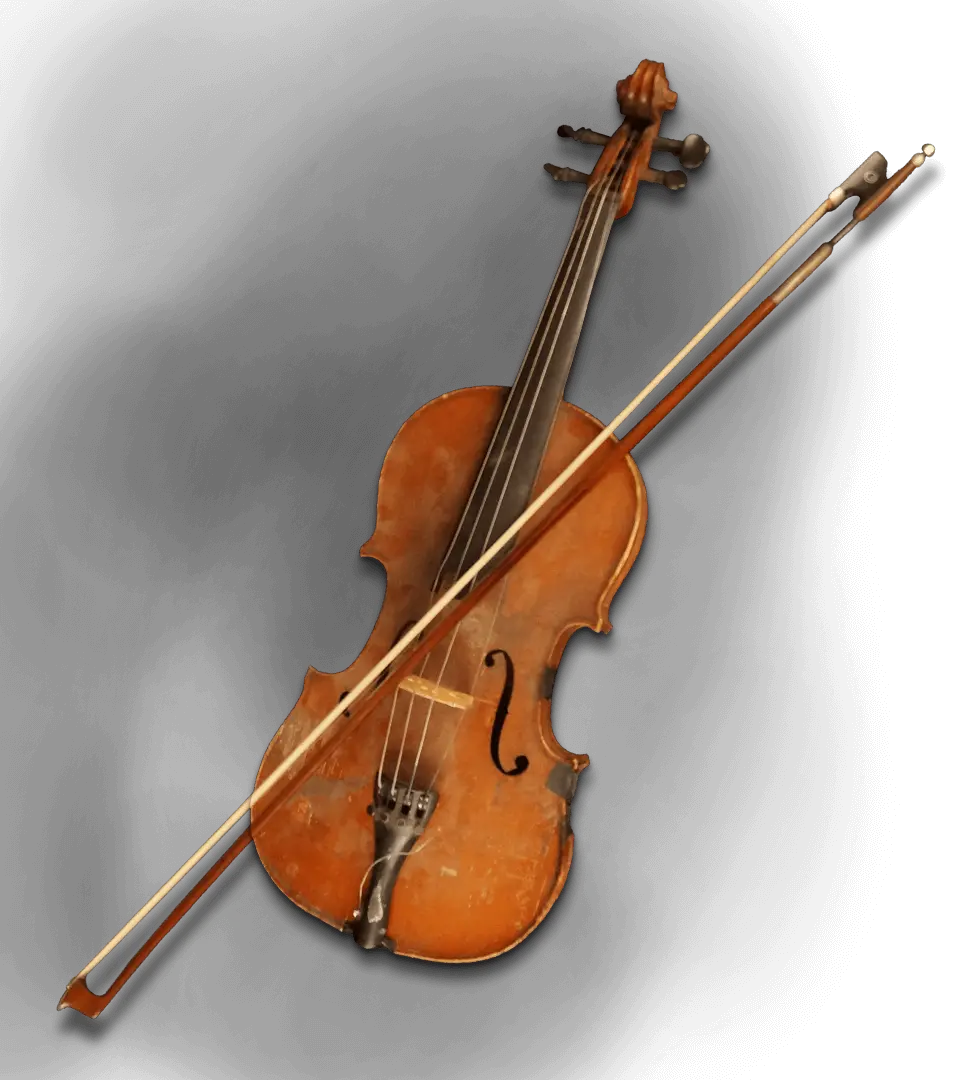
![]()
 International
International
Seàn Cleland’s fiddle from The Drovers
Founded in 1988, The Drovers were a popular touring Irish band from Chicago. They recorded several albums and were also featured in two motion pictures, Backdraft (1991) and Blink (1993). The band’s founder, Seàn Cleland, modified this fiddle to run through an amplifier for live performances.
Courtesy of Seàn Cleland, The Drovers founder and fiddle player
![]()
![]() Asrat Aemro Selassie, Chicago, IL, (born in Ethiopia)
Asrat Aemro Selassie, Chicago, IL, (born in Ethiopia)
Asrat Aemro Selassie, Chicago, IL, (born in Ethiopia)
International
The late Asrat Selassie and his band Dallol migrated to Chicago from Ethiopia in 1980. Dallol became the backing band for Ziggy Marley in the late 1980s and in 1985 Selassie co-founded the Wild Hare reggae club near Chicago’s Wrigley Field. The historic venue booked iconic acts like Jimmy Cliff, Toots and the Maytals, and more. The Wild Hare became an important point of entry for Caribbean immigrants in the Chicago area.
![]()
![]() Tatsu Aoki, Chicago, IL, (born in Japan)
Tatsu Aoki, Chicago, IL, (born in Japan)
Tatsu Aoki, Chicago, IL, (born in Japan)
International
Multi-instrumentalist Tatsu Aoki left his native Tokyo Japan in 1977 to study filmmaking at the School of the Art Institute in Chicago. He became a long-time bassist for the late Chicago bop saxophonist Fred Anderson and also has collaborated with Chicago jazz giants like Von Freeman and Jeff Parker. That’s the magic of aspiration.
![]()
![]() Sones de México, Mexican-American band from Chicago, IL
Sones de México, Mexican-American band from Chicago, IL
Sones de México, Mexican-American band from Chicago, IL
International
All of this world music can soothe a singular soul. These hybrids have been played at anniversaries, birthdays, weddings, and funerals across the wide-ranging State of Illinois. The collective elements of this immigrant sound created a new dance card. It is the soundtrack of a land filled with possibility, power, and the promise of a better tomorrow.
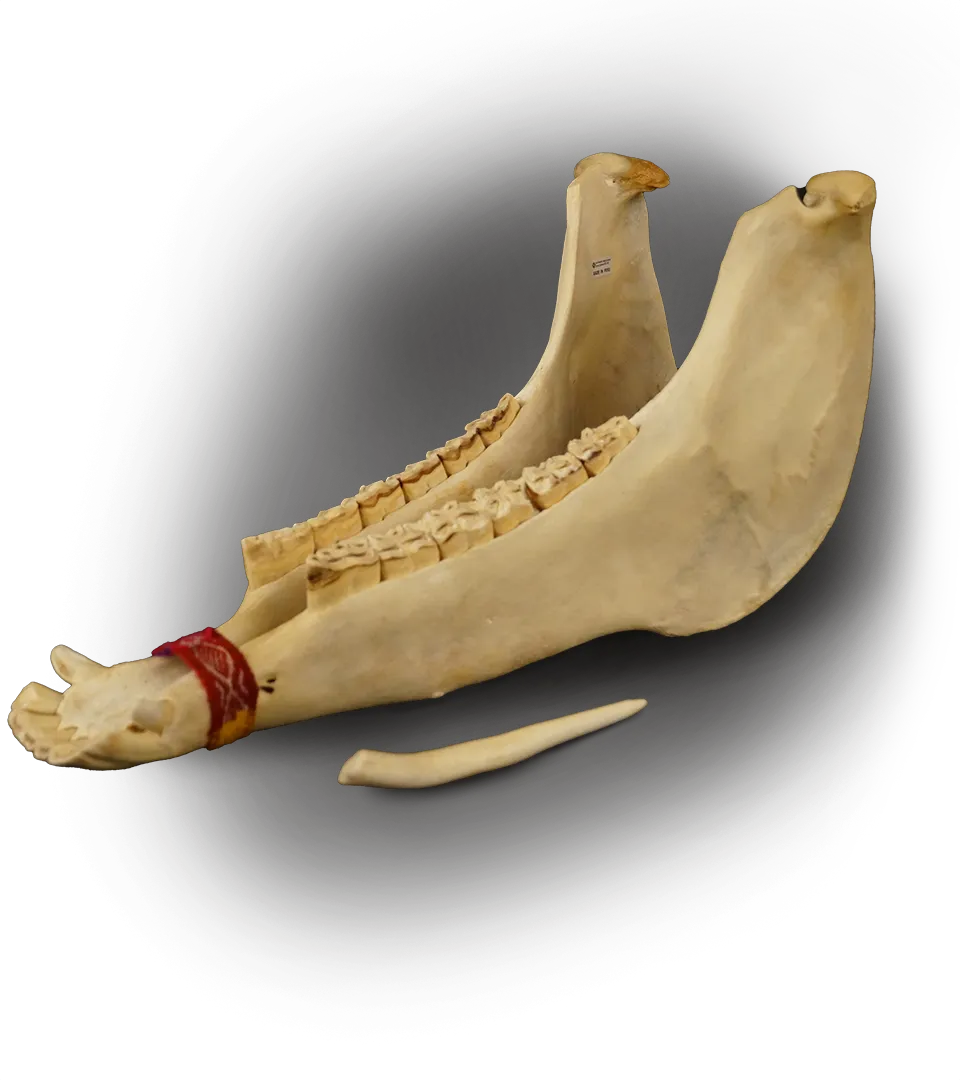
![]()
International
Donkey Jaw and Antler Instrument from Sones de México
Sones de México is an ensemble organization specializing in Mexican ”Son,” including the regional styles of Huapango, Gustos, Chilenas, Son Jarocho, and more. This traditional jawbone instrument, known as a quijada, produces a powerful buzzing sound like a rattle.
Courtesy of Sones de México Ensemble

![]()
![]() Walter "Li'l Wally" Jagiello, Chicago, IL, (Polish heritage)
Walter "Li'l Wally" Jagiello, Chicago, IL, (Polish heritage)
Walter "Li'l Wally" Jagiello, Chicago, IL, (Polish heritage)
International
Li’l Wally’s Chemnitzer Concertina
Li’l Wally (Walter Jagiello) was a Chicago-style polka master musician who sang in both Polish and English. This highly decorated concertina (similar to an accordion) was Wally’s prized possession and primary instrument, along with the drums.
Courtesy of the Estate of Walter Jagiello and Jay Jay Record Co.
![]()
![]() Eddie Blazonczyk, Chicago, IL, (Polish heritage)
Eddie Blazonczyk, Chicago, IL, (Polish heritage)
Eddie Blazonczyk, Chicago, IL, (Polish heritage)
International
Eddie Blazonczyk, Sr., 1986 Grammy Award for Best Polka Recording
Eddies Blazonczyk, Sr.’s, Versatones won this Grammy Award for the record, Another Polka Celebration. He recorded the album in his own Chicago studio for his Bel-Aire label, which he started in 1963.
Courtesy of Eddie Blazonczyk, Jr.
![]()
![]() Gretchen Wilson, Pocahontas, IL
Gretchen Wilson, Pocahontas, IL
Gretchen Wilson, Pocahontas, IL
Americana & Country
Road to Adventure — Country Music in Illinois
During the mid-20th century, it was common to hear Country and Western music on the radio. It was a compass to the American migration, whether it be to northern industrial cities or west along the magical ribbon of Route 66. By the 1980s, more country radio stations fell into the hands of corporate ownership and focus groups. The truth was lost. A new generation of adventurous Country singers had limited options.
Americana was born.
![]()
![]() Jason Ringenberg (The Godfather of Americana), Kewanee, IL
Jason Ringenberg (The Godfather of Americana), Kewanee, IL
Jason Ringenberg (The Godfather of Americana), Kewanee, IL
Americana & Country
Americana music is identified with a progressive Country
Americana music is identified with a progressive Country sound that incorporates Rock, Folk, and Bluegrass. But it stretches into a pastiche of American roots music that includes Gospel, Blues, lost Honky-Tonk, and Rhythm and Blues Music. The generous rewards for the listener have been all over the map.
![]()
![]() Alison Kraus, Decatur, IL
Alison Kraus, Decatur, IL
Alison Kraus, Decatur, IL
Americana & Country
Who could have imagined a young girl from Decatur, IL, (Alison Krauss) having a successful artistic collaboration with the lead singer of Led Zeppelin (Robert Plant)?
![]()
![]() The Mekons, Chicago, IL
The Mekons, Chicago, IL
The Mekons, Chicago, IL
Americana & Country
Or a punk band from Leeds, England (the Mekons, with Jon Langford and Sally Timms) landing in Chicago and learning about traditional country music and dress under the charms of the Sundowners?
![]()
![]() The Waco Brothers, Chicago, IL
The Waco Brothers, Chicago, IL
The Waco Brothers, Chicago, IL
Americana & Country
As the Mekons concentrated more on punk, Jon Langford started The Waco Brothers from his desire to perform more country-influenced music.
![]()
![]() Robbie Fulks, long-time Chicago resident
Robbie Fulks, long-time Chicago resident
Robbie Fulks, long-time Chicago resident
Americana & Country
There are no boundaries in the music of Chicago’s Robbie Fulks with a repertoire that includes traditional Country, Folk, Pop, Bluegrass, and Michael Jackson.
![]()
![]() Shel Silverstein, Chicago, IL
Shel Silverstein, Chicago, IL
Shel Silverstein, Chicago, IL
Americana & Country
Don’t forget Chicago songwriter Shel Silverstein (1930-1999). Besides being a successful children’s author and poet, the former Roosevelt University student wrote the country hit “A Boy Named Sue” for Johnny Cash,” “Tequila Shelia” for Bobby Bare Sr., and “Queen of the Silver Dollar” for Emmylou Harris.
![]()
![]() Wilco, Chicago, IL
Wilco, Chicago, IL
Wilco, Chicago, IL
Americana & Country
If you find the right exit ramps, Country music remains compelling, rebellious, and full of discovery. Its Illinois roots are responsible for much of that energy.
![]()
![]() Farm Aid 1
Farm Aid 1
Farm Aid 1
Americana & Country
The first-ever Farm Aid Concert was held at the University of Illinois's Memorial Stadium, on September 22, 1985. Performers included Willy Nelson, Bob Dylan, Billy Joel, B.B. King, Loretta Lynn, Roy Orbison, Tom Petty, and many more of the royalty of Country music. The event drew 80,000 people and raised $9 million for U.S. family farms.
Courtesy of Mike DuBois
![]()
-
![]() Brad Eldredge, Paris, IL
Brad Eldredge, Paris, IL
-
![]() Bob Dylan and Tom Petty at the first Farm Aid, Champaign, IL
Bob Dylan and Tom Petty at the first Farm Aid, Champaign, IL
-
![]() Carol King at the first Farm Aid, Champaign, IL
Carol King at the first Farm Aid, Champaign, IL
-
![]() Glen Campbell at the first Farm Aid, Champaign, IL
Glen Campbell at the first Farm Aid, Champaign, IL
-
![]() Johnny Cash and Waylon Jennings at the first Farm Aid, Champaign, IL
Johnny Cash and Waylon Jennings at the first Farm Aid, Champaign, IL
-
![]() Neil Young at the first Farm Aid, Champaign, IL
Neil Young at the first Farm Aid, Champaign, IL
-
![]() Jason Ringenberg (Godfather of Americana), Kewanee, IL
Jason Ringenberg (Godfather of Americana), Kewanee, IL
-
![]() Jonas Friddle, Chicago, IL
Jonas Friddle, Chicago, IL
-
![]() Suzy Bogguss, Aledo, IL
Suzy Bogguss, Aledo, IL
-
![]() Jon Langford from The Mekons, Chicago, IL
Jon Langford from The Mekons, Chicago, IL
-
![]() Sally Timms from The Mekons, Chicago, IL
Sally Timms from The Mekons, Chicago, IL
-
![]() Wilco, Chicago, IL
Wilco, Chicago, IL
-
![]() Jeff Tweedy from Wilco, Chicago, IL
Jeff Tweedy from Wilco, Chicago, IL
![]()
![]() Chicago, Chicago, IL
Chicago, Chicago, IL
Chicago, Chicago, IL
Rock
Rock and Roll's Genuine Sound
Illinois rock n’ roll is a cacophony of true emotion. Guitars, drums, keyboards, horns, tambourines, and voices come together from Zion to Metropolis. Bend me, shape me. rock n’ roll is liberation. It can be about love and loneliness and cars and bars.
![]()
![]() REO Speedwagon, Champaign, IL
REO Speedwagon, Champaign, IL
REO Speedwagon, Champaign, IL
Rock
There’s a straight-to-the-heart fabric in Illinois rock n’ roll. The sound of REO Speedwagon is direct, while there’s vehicular Berwyn muscle in the Ides of March.
![]()
![]() Styx, Chicago, IL
Styx, Chicago, IL
Styx, Chicago, IL
Rock
Sonically ambitious dreams define many of the ballads of Styx and Richard Marx.
![]()
![]() Head East, East Central Illinois
Head East, East Central Illinois
Head East, East Central Illinois
Rock
On the flip side, there’s no escaping the working-class endurance of Head East (formed in 1969 in Carbondale).
![]()
![]() Dan Fogelberg, Peoria, IL
Dan Fogelberg, Peoria, IL
Dan Fogelberg, Peoria, IL
Rock
Illinois is the mainline of American rock n’ roll. Look no further than Chuck Berry’s road trips from St. Louis to record at Chess Records in Chicago or Dan Fogelberg meshing Southern California rock with his Peoria roots.
![]()
![]() OK Go, Chicago, IL
OK Go, Chicago, IL
OK Go, Chicago, IL
Rock
Possibility has always lived across our prairie horizon. The promise of rock n’ roll is equal to its past.
![]()
-
![]() Chevelle, Grayslake, IL
Chevelle, Grayslake, IL
-
![]() Platinum record for the Chicago 17 album
Platinum record for the Chicago 17 album
-
![]() Dan Fogelberg, Peoria, IL
Dan Fogelberg, Peoria, IL
-
![]() Freddy Jones, Chicago, IL
Freddy Jones, Chicago, IL
-
![]() Jim Peterik from the bands Survivor and Ides of March, Berwyn, IL
Jim Peterik from the bands Survivor and Ides of March, Berwyn, IL
-
![]() Plain White T's, Lombard, IL
Plain White T's, Lombard, IL
-
![]() REO Speedwagon, Champaign, IL
REO Speedwagon, Champaign, IL
-
![]() Richard Marx, Chicago, IL
Richard Marx, Chicago, IL
-
![]() Styx, Chicago, IL
Styx, Chicago, IL
-
![]() James Young's guitar from the band Styx
James Young's guitar from the band Styx
-
![]() Survivor, Chicago, IL
Survivor, Chicago, IL
![]()
![]() Cheap Trick, Rockford, IL
Cheap Trick, Rockford, IL
Cheap Trick, Rockford, IL
Power Pop
Power of Pop along the Illinois Plains
Power Pop. It goes together like the straight and narrow or a bow and an arrow. The Power is aimed at the heart with tight chords, nothing too fancy but always appointed. The Pop is melodic and playful. There is no option but to “Surrender,” as Rockford’s Cheap Trick sang in 1978.
![]()
![]() Cryan Shames, Hinsdale, IL
Cryan Shames, Hinsdale, IL
Cryan Shames, Hinsdale, IL
Power Pop
Pop music was a smooth creation of the 1950s and early 1960s that was grounded in song structure. Illinois proved to be a fertile ground for mid-1960s pop bands like the Cryan’ Shames, the New Colony Six, and Shadows of Knight because of hormone-charged high school gymnasiums and teen clubs like the nomadic Dex Card’s Wild Goose in the Chicago area. By the 1970s tireless Central Illinois promoter Len Trumper was booking pop and rock into the Illinois State Armory and the Ice Chateau in Springfield as well as the Pekin Memorial Arena.
![]()
![]() Pezband, Oak Park, IL
Pezband, Oak Park, IL
Pezband, Oak Park, IL
Power Pop
Power pop amped up in the late 1970s with blazing guitars, drums, occasional keyboards, and driving harmonies. Tommy Gauvenda, guitarist for the Oak Park Pop band Pezband once said that, if New York was the Stones, Chicago was the Beatles. And there was an accessible groove to the heartland sound.
![]()
![]() Shoes, Zion, IL
Shoes, Zion, IL
Shoes, Zion, IL
Power Pop
Power Pop exploded across Illinois. For every band that scored major radio airplay, like Cheap Trick, Zion’s Shoes, and Blue Island’s Enuff z’ Nuff, so many others were toiling away in the garages and basements of Champaign-Urbana, Carbondale, Peoria, and other ports.
![]()
![]()
Power Pop
Material Issue
During the mid-1980s Chicago-based Material Issue quickly gained popularity. Other Chicago bands like the Slugs and Green dipped into the “Mod” movement along with Champaign’s the Outnumbered. These nattily dressed groups were influenced by the Who’s “Quadrophenia.” “Mods” regularly gathered at the small Chicago rock club the West End which was the precursor to the iconic Lounge Ax.
![]()
![]() Off Broadway, Oak Park, IL
Off Broadway, Oak Park, IL
Off Broadway, Oak Park, IL
Power Pop
Off Broadway
Illinois has been a linchpin of Power Pop for sixty years. It never hoped to die before it got old. It evolved with joy and discovery. Power Pop musicians were devoted to blowing off steam and that was all that mattered. Music captured with such uncompromising passion is often the most memorable.
![]()
Power Pop
Power Pop Gallery
-
![]() Rick Nielsen of Cheap Trick, Elmhurst, IL
Rick Nielsen of Cheap Trick, Elmhurst, IL
-
![]() Custom Hamer guitar owned by Rick Nielsen of Cheap Trick
Custom Hamer guitar owned by Rick Nielsen of Cheap Trick
-
![]() Cheap Trick, Rockford, IL
Cheap Trick, Rockford, IL
-
![]() Enuff z’ Nuff, Blue Island, IL
Enuff z’ Nuff, Blue Island, IL
-
![]() Kevin Lee & Heartbeat, Chicago, IL
Kevin Lee & Heartbeat, Chicago, IL
-
![]() Kevin Lee & Heartbeat, Chicago, IL
Kevin Lee & Heartbeat, Chicago, IL
-
![]() Pezband’s hand-painted drumhead inspired by the Schlitz Brewing Co. logo
Pezband’s hand-painted drumhead inspired by the Schlitz Brewing Co. logo
-
![]() Off Broadway, Oak Park, IL
Off Broadway, Oak Park, IL
-
![]() Shoes, Zion, IL
Shoes, Zion, IL
-
![]() Custom-made Hamer guitar for Jeff Murphy of Shoes
Custom-made Hamer guitar for Jeff Murphy of Shoes
-
![]() The Elvis Brothers, Champaign, IL
The Elvis Brothers, Champaign, IL
-
![]() The Kind, Belmont Heights, IL
The Kind, Belmont Heights, IL
-
![]() Various artifacts from The Kind, Belmont Heights, IL
Various artifacts from The Kind, Belmont Heights, IL
-
![]() The Buckinghams, Chicago, IL
The Buckinghams, Chicago, IL
![]()
![]() The Emotions, Chicago, IL
The Emotions, Chicago, IL
The Emotions, Chicago, IL
House & Disco
The Connection Between Disco and House Music is Unique to Illinois
During Disco’s powerhouse years of the mid-1970s, the Rhythm and Blues-influenced dance music crossed over to rock clubs and nightclubs from Chicago to Carbondale. When Disco was in the groove, it created a sense of freedom and broke down cultural and sexual boundaries.
![]()
![]() Earth, Wind & Fire, Chicago, IL
Earth, Wind & Fire, Chicago, IL
Earth, Wind & Fire, Chicago, IL
House & Disco
However, gaudy outfits, orgasmic lyrics, layered synthesizers, and blow-dried hair defined Disco on a commercial level. In the early 1980s, Faces on Rush Street emerged as Chicago’s cologne-inspired cousin to Studio 54 in New York. At the same time, celebrity actor Mr. T got his start as a bouncer at Dingbat’s, a near north side Chicago Disco that even hosted a Sunday afternoon “kiddy disco.”
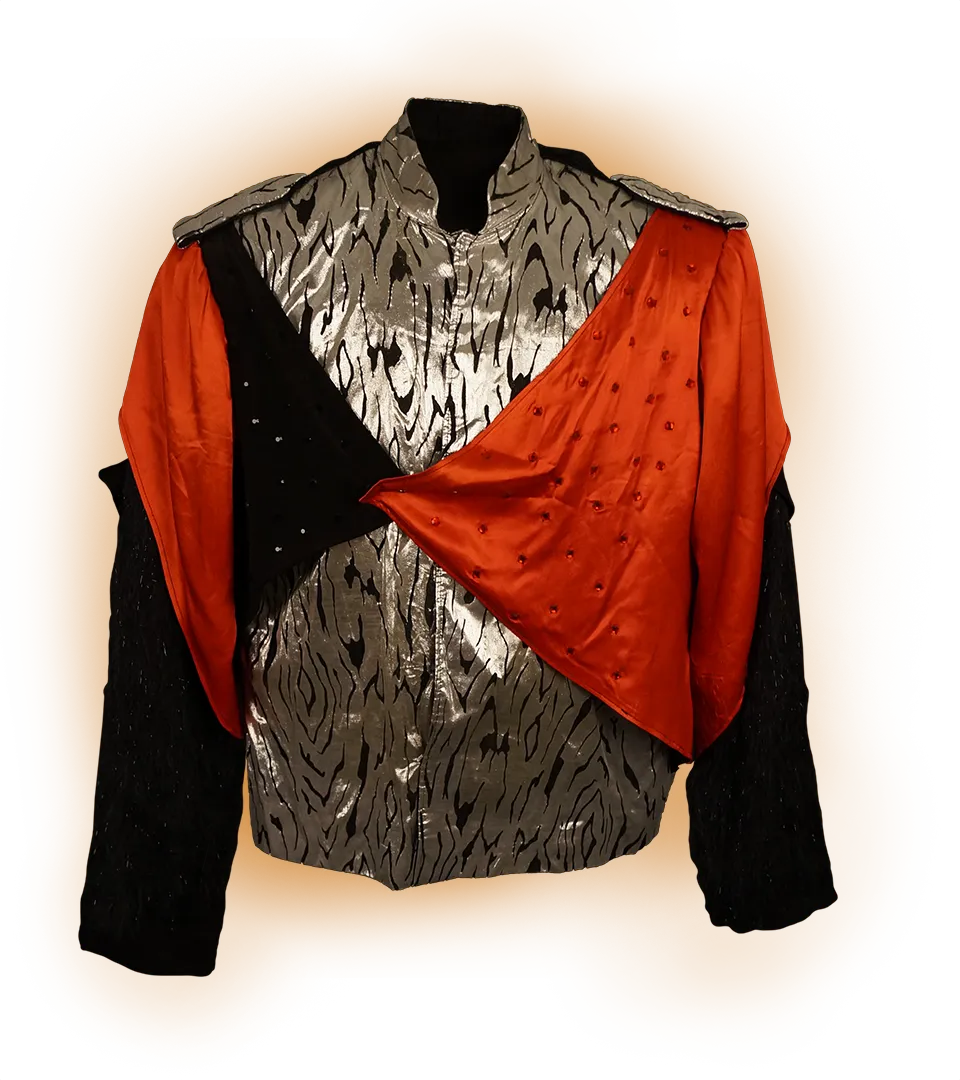
![]()
House & Disco
Stage Costume Jacket from Earth, Wind & Fire
This glamorous stage costume jacket was worn by a backing band member of Earth, Wind & Fire. One of the most iconic R&B and Disco artists, EWF came together in Chicago in 1969. Their music has evolved over the years as they continue to put on a show like no other.
Courtesy of the Collection of The Rock & Roll Hall of Fame

![]()
![]()
House & Disco
All this noise made the genre an easy target for satire – none as remarkable as 1979’s Disco Demolition at Comiskey Park in Chicago. The promotion was sponsored by rock station WLUP-FM and hosted by popular on-air provocateurs Steve Dahl and Garry Meier. A small riot ensued and the second game of the White Sox doubleheader was canceled. The stunt attracted worldwide attention.
This was the day commercial disco died.
![]()
![]() Frankie Knuckles (Godfather of House), Chicago, IL, (born in New York)
Frankie Knuckles (Godfather of House), Chicago, IL, (born in New York)
Frankie Knuckles (Godfather of House), Chicago, IL, (born in New York)
House & Disco
House music followed. Its beat was closer to the street and it defied any marketing. It was real. Frankie Knuckles (1955-2014) was the maestro of Chicago’s internationally known House Music scene. By the late 1970s, he saw that record companies had stopped signing Disco acts, so he created his own deal. House has a fast rhythm (up to 120 beats per minute) that is drenched in body movement.
![]()
![]()
House & Disco
Technics 1100A Turntable Used by Frankie Knuckles
Frankie Knuckles used this turntable in the Warehouse nightclub in Chicago during his career as a pioneer and innovator of House Music. Knuckles was considered a master at utilizing multiple turntables to create unique sound experiences.
Courtesy of the Estate of Frankie Knuckles & the Frankie Knuckles Foundation
![]()
![]() Steve "Silk" Hurley, Chicago, IL
Steve "Silk" Hurley, Chicago, IL
Steve "Silk" Hurley, Chicago, IL
House & Disco
Its bass-heavy nature punctuated Knuckles’ early samples of Talking Heads, the Police, Dr. Martin Luther King’s “I Have a Dream” speech, and more. The art of mixing in House music employed more effects and created a more trippy vibe than Disco. House music has emerged as one of Chicago’s most important cultural exports along with the blues and the Chicago Symphony Orchestra.
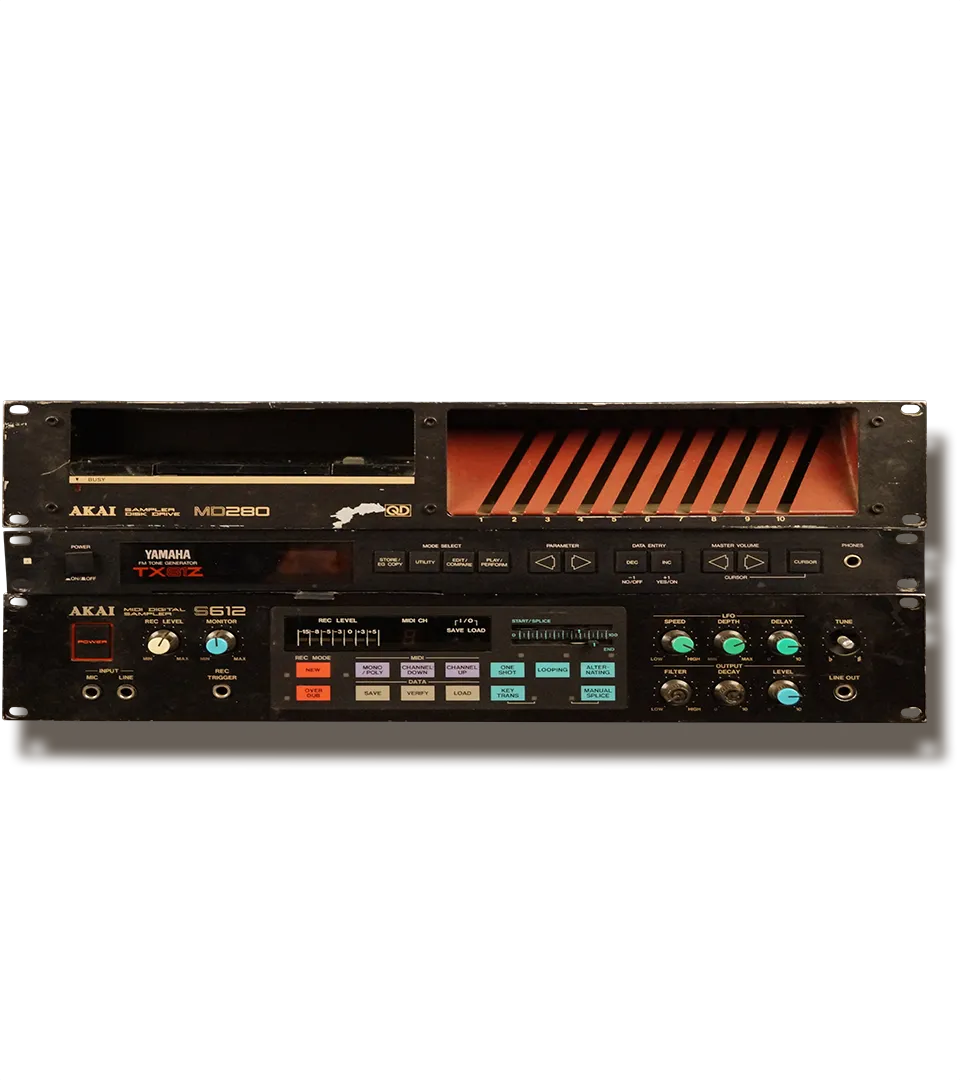
![]()
House & Disco
Steve “Silk” Hurley’s Yamaha TX 81Z Synth Module
Steve “Silk” Hurley became a sought-after remixer/producer for other artists. For a decade starting in 1988, this synth was his primary instrument to create new mixes for Michael Jackson, CeCe Peniston, Inner City, Ten City, Madonna, Jomanda, and others.
Courtesy of Steve “Silk” Hurley

![]()
![]() Derrick Carter, Chicago, IL, (born in California)
Derrick Carter, Chicago, IL, (born in California)
Derrick Carter, Chicago, IL, (born in California)
House & Disco
Knuckles said, “House Music is Disco’s Revenge.” And without House, there’s no EDM (Electronic Dance Music), no Liz Torres (bi-lingual Latin House) no Derrick Carter (soul and jazz-influenced House), and a new generation of DJs and artists like Lady Gaga, who has employed deep House and electro House. Just like all powerful musical genres, House music continues to move forward with adventure and passion.
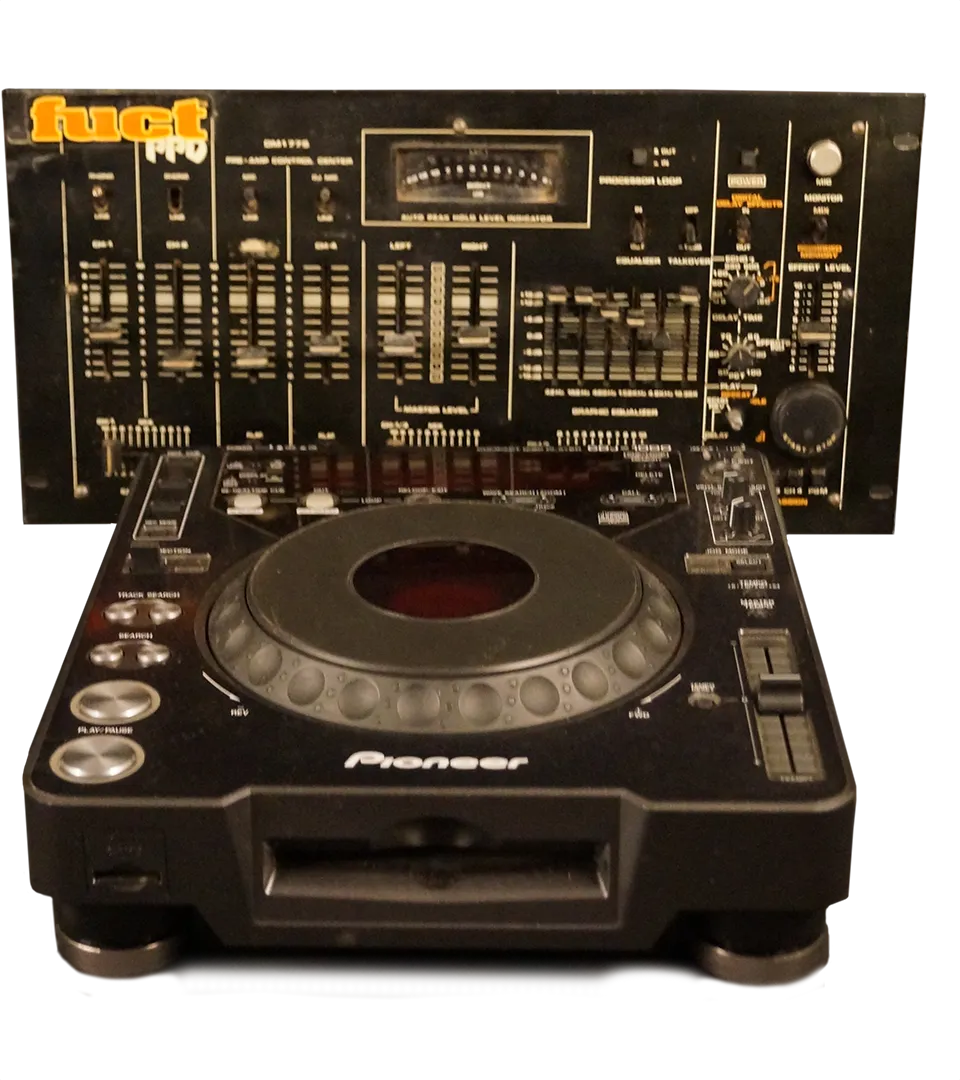
![]()
House & Disco
Digital Turntable Owned by Derrick Carter
This CDJ-1000 digital turntable is owned by musician, producer, and DJ Derrick Carter. An international superstar and master of underground House keyboards, Carter grew up in the western suburbs of Chicago. Over the last thirty years, he has been a sought-after global remixer for top artists including Fine Young Cannibals.
Courtesy of Derrick Carter

![]()
![]() Ministry, Chicago, IL
Ministry, Chicago, IL
Ministry, Chicago, IL
Industrial & Metal
Spot welding the sounds of Industrial and Metal music personifies some of the grittiest parts of middle America. Industrial music broke out in the mid-1970s with sparks of punk smacking up against electronics and ambient Rock n’ Roll. Industrial was also one of the first popular music genres to explore technology as a medium to deliver its sound.
![]()
![]() Mudvayne, Peoria, IL
Mudvayne, Peoria, IL
Mudvayne, Peoria, IL
Industrial & Metal
Metal has some of the most devoted concert and consumer brands in all of popular music. Often characterized by loud drums and distorted guitars, metal emerged in the late 1960s and early 1970s through the commercial successes of Led Zeppelin and Deep Purple. The working-class suburb of Aurora was forever immortalized as a metal nirvana in the 1992 hit comedy film “Wayne’s World.”
![]()
![]() Steve Albini, Chicago, IL, (born in California)
Steve Albini, Chicago, IL, (born in California)
Steve Albini, Chicago, IL, (born in California)
Industrial & Metal
Musician-audio engineer Steve Albini is the architect of a Chicago industrial sound that contains artistic empathy. Albini was a player in early Chicago fanzines like Matter. While at Northwestern, in 1981, he formed the punk band Big Black. Albini has worked on several thousand albums as a musician, recording engineer, and producer; a term he eschews. He has collaborated with Cheap Trick, Nirvana & many more. Albini remains active with his noise band Shellac, a hard-charging trio he helped form in 1992.
![]()
![]() Wax Trax! Records, Chicago, IL
Wax Trax! Records, Chicago, IL
Wax Trax! Records, Chicago, IL
Industrial & Metal
The legacy of Wax Trax! Records in Chicago, Ministry, and Disturbed have influenced a new generation of musicians. Wax Trax! opened in 1978 in Lincoln Park as a go-to store for punk and power pop vinyl. The store is long gone but in 2014 the label was reborn by Julia Nash, daughter of the late co-founder Jim Nash.
![]()
![]() Ministry, Chicago, IL
Ministry, Chicago, IL
Ministry, Chicago, IL
Industrial & Metal
By 1981 it established a small Wax Trax! label and its release of Ministry’s “Cold Life” created the industrial imprint that remains today.
![]()
![]()
Industrial & Metal
Ministry Stage “Prop” Microphone Stand
Industrial music giants, Ministry, have created scenic centerpiece microphone stands for frontman Al Jourgensen since 1992. This stand was designed and built by Largent Studios in 2012 for the Defibrila Tour and graces the cover of the Last Tangle in Paris live record.
Courtesy of the private collection of Al Jourgensen
![]()
![]() My Life With The Thrill Kill Kult, Chicago, IL
My Life With The Thrill Kill Kult, Chicago, IL
My Life With The Thrill Kill Kult, Chicago, IL
Industrial & Metal
In the neon-lit spring haze of '87, Frankie Nardiello and Marston Daley met while touring with Ministry. They thought up the idea of a new art film they would call My Life with the Thrill Kill Kult. While never completed, the music was released by Wax Trax! Records, and the new Thrill Kill Kult, along with Ministry and other Wax Trax! musicians, industrial music was born.
![]()
![]() Disturbed, Chicago, IL
Disturbed, Chicago, IL
Disturbed, Chicago, IL
Industrial & Metal
The Chicago metal band Disturbed has sold more than 17 million records worldwide, making them one of the most popular bands of the genre. Lead guitarist-keyboardist Dan Donegan started Disturbed in 1994. A native of suburban Oak Lawn, Donegan is a self-taught guitarist, having fused fusing rock with dense metal.
![]()
![]() Disturbed, Chicago, IL
Disturbed, Chicago, IL
Disturbed, Chicago, IL
Industrial & Metal
In 2000 Disturbed released “The Sickness,” its debut studio album. It has since been certified five times platinum for shipments of over five million copies in the U.S. And Disturbed is still going strong. Deploying a heavier sound that harkened back to its roots, the band’s December 2022 release “Divisive” debuted at number 3 on the Billboard magazine Rock Album Chart and number one on the Alternative Albums Chart. There’s no argument that Industrial and Metal have put some of the most passionate noise in Illinois.
![]()
-
![]() Disturbed, Chicago, IL
Disturbed, Chicago, IL
-
![]() Mudvayne, Peoria, IL
Mudvayne, Peoria, IL
-
![]() Pigface, Chicago, IL
Pigface, Chicago, IL
-
![]() Sacred Warrior, Chicago, IL
Sacred Warrior, Chicago, IL
-
![]() Sister Machine Gun, Chicago, IL
Sister Machine Gun, Chicago, IL
-
![]() Stabbing Westward, Macomb, IL
Stabbing Westward, Macomb, IL
-
![]() State of Sound exhibit
State of Sound exhibit
-
![]() State of Sound exhibit
State of Sound exhibit
![]()
![]() Tom Morello, Libertyville, IL, (born in New York)
Tom Morello, Libertyville, IL, (born in New York)
Tom Morello, Libertyville, IL, (born in New York)
Alternative & Punk
No Rock n' Roll Sound Combines Attitude with Music as much as Punk
Panache and often politics were on the gritty ground floor of the Punk movement. Loud guitars and scorching vocals only amplified the attitude. Songs were short and layered with a blitzkrieg of sound and emotion. Every moment counted. Punk’s aggression of the late 1970s was sharply contrasted by the commercial success of Disco.
![]()
![]() Liz Phair, Chicago, IL, (born in Connecticut)
Liz Phair, Chicago, IL, (born in Connecticut)
Liz Phair, Chicago, IL, (born in Connecticut)
Alternative & Punk
Punk was as dramatic as a high-speed swerve on Du Sable Lake Shore Drive.
In Chicago, circa 1977, punks and gays were dancing into the early morning at the underground Le Mere Vipere, while several blocks south an elite crowd was getting their Disco on at Faces on Rush Street. Life was moving to different beats. Something had to snap.
![]()
![]() Naked Raygun, Chicago, IL
Naked Raygun, Chicago, IL
Naked Raygun, Chicago, IL
Alternative & Punk
The best thing about Chicago punk is how it flew under the radar of scenes in Los Angeles and New York. Chicago punk musicians had more room to experiment. The first punk wave included Tu Tu and the Pirates, Naked Raygun, and the Effigies.
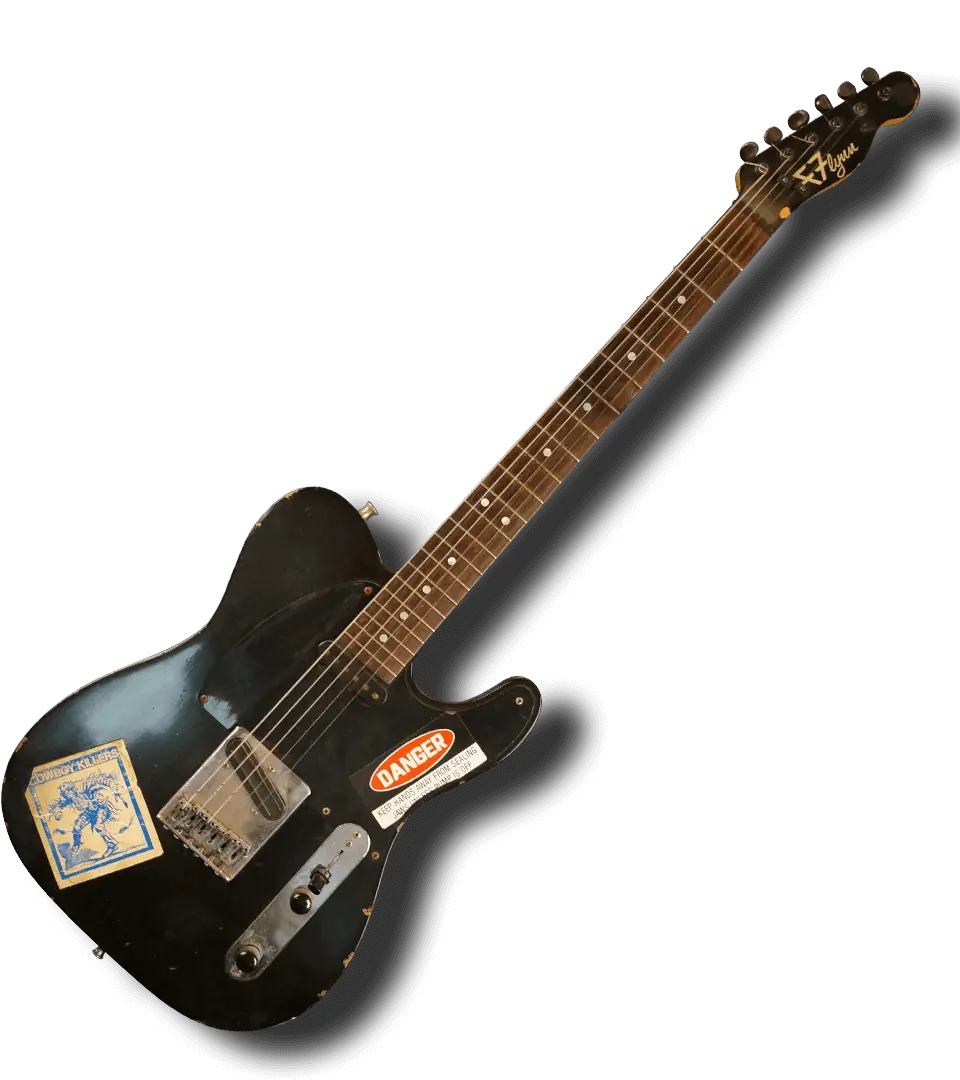
![]()
Alternative & Punk
Naked Raygun vocalist, Jeff Pezzati's Guitar
Naked Raygun is a pioneering and influential band from Chicago’s punk scene. The band started in 1980 on the city’s south side Beverly neighborhood. Vocalist Jeff Pezzati used this Telecaster-styled guitar, made in Evanston, Illinois, by Flynn Guitars, in the early part of his career with the band.
Courtesy of Jeff Pezzati - Musician and Songwriter

![]()
![]() Smashing Pumpkins, Chicago, IL
Smashing Pumpkins, Chicago, IL
Smashing Pumpkins, Chicago, IL
Alternative & Punk
When Chicago punk was “discovered” by record labels and Billboard magazine in the mid-1980s, it morphed into Alternative Rock. This evolution embraced the same DIY attitude as Punk, opening up a landscape for Urge Overkill, Smashing Pumpkins, and Wilmette’s Fall Out Boy.
Far away from the city, the punk movement was becoming equally fertile. Late 1980s Peoria punkers Despondent Youth and Bloody Mess & the Skabs (punk and thrash) were noticed by national publications like Maximum Rock n’ Roll. Bloody Mess even found his way onto the Phil Donahue television show. Bands like the MC5, Black Sabbath, and the Who made sure to include Peoria on their itinerary.
![]()
![]()
Alternative & Punk
The Smashing Pumpkins Billboard #1 Award
The Smashing Pumpkins’ landmark album, Mellon Collie and the Infinite Sadness further solidified their careers as global superstars. This Billboard Magazine Award presented to drummer Jimmy Chamberlin marks the period when the record was #1 on Billboard’s Top 200 Albums chart.
Courtesy of the Estate of Jimmy Chamberlin
![]()
![]() Rise Against, Chicago, IL
Rise Against, Chicago, IL
Rise Against, Chicago, IL
Alternative & Punk
The punk band Rise Against emerged when Chicago’s hardcore music scene was rocking in 1999. They have released nine albums, some of which achieved mainstream success and charted worldwide. The band is known for its melodic and aggressive music, as well as its social and political activism.
![]()
![]()
Alternative & Punk
Rise Against’s Guitar
During Rise Against’s early tours and recording sessions, lead singer-lyricist-rhythm guitarist Tim McIllrath favored a white Gibson Les Paul. The words “Out of Step” printed in bold black letters on the back of the guitar is an homage and reference to a song and album by Washington, D.C., DIY Punk Pioneers.
![]()
-
![]() 11th Dream Day, Chicago, IL
11th Dream Day, Chicago, IL
-
![]() Fall Out Boy, Wilmette, IL
Fall Out Boy, Wilmette, IL
-
![]() Liz Phair, Chicago, IL, (born in Connecticut)
Liz Phair, Chicago, IL, (born in Connecticut)
-
![]() Naked Raygun, Chicago, IL
Naked Raygun, Chicago, IL
-
![]() Pegboy, Chicago, IL
Pegboy, Chicago, IL
-
![]() Rise Against, Chicago, IL
Rise Against, Chicago, IL
-
![]() Skafish, Chicago, IL
Skafish, Chicago, IL
-
![]() Smashing Pumpkins, Chicago, IL
Smashing Pumpkins, Chicago, IL
-
![]() Smashing Pumpkins’ custom drumhead for the 2007 Zeitgeist Tour, Chicago, IL
Smashing Pumpkins’ custom drumhead for the 2007 Zeitgeist Tour, Chicago, IL
-
![]() The Effigies, Chicago, IL
The Effigies, Chicago, IL
-
![]() Tom Morello, Libertyville, IL, (born in New York)
Tom Morello, Libertyville, IL, (born in New York)
-
![]() Urge Overkill, Chicago, IL
Urge Overkill, Chicago, IL
-
![]() Veruca Salt, Chicago, IL
Veruca Salt, Chicago, IL
![]()
![]() Lil Durk, Englewood, Chicago, IL
Lil Durk, Englewood, Chicago, IL
Lil Durk, Englewood, Chicago, IL
Rap & Hip Hop
The Beat in a City of Big Shoulders
Cities have always provided a fertile ground for new music, from up on the roof to under the boardwalk. But life in contemporary America has set the tone for the most intense urban marriage of Hip-Hop and Rap. This is poetry with a scorching beat. This is street dance. This is basketball. Hip-Hop and Rap have grown beyond their early inner-city origins into the suburbs and rural communities across Illinois.
![]()
![]() Ludacris, Champaign, IL
Ludacris, Champaign, IL
Ludacris, Champaign, IL
Rap & Hip Hop
Hip-Hop is shaped by a quadrant of deliverance: deejaying, split-speed MCing, stunning graffiti, and dance. Rap has a more linear edge defined by strong beats and freestyling rhymes.
![]()
![]() Queen Key, Chicago, IL
Queen Key, Chicago, IL
Queen Key, Chicago, IL
Rap & Hip Hop
The debate continues between the idea that Rap is a type of music, whereas Hip-Hop is a way of life. Rappers are like modern-day calypsonians, rapping and rhyming about social issues. Often, Hip-Hop’s more expansive grooves create space to look towards tomorrow.
![]()
![]() Common, South Side, Chicago, IL
Common, South Side, Chicago, IL
Common, South Side, Chicago, IL
Rap & Hip Hop
Chicago’s Common (Lonnie Rashid Lynn, Jr.) used a neo-Soul groove to cross over into Hollywood, where he won a 2015 Academy Award for Best Original Song for “Glory” from the 2014 film “Selma,” in which he also appeared.
![]()
![]() Chance the Rapper, Chicago, IL
Chance the Rapper, Chicago, IL
Chance the Rapper, Chicago, IL
Rap & Hip Hop
Chance the Rapper (Chancelor Jonathan Bennett) was born and raised in Chicago where he began distributing his music on mixtapes. His third mixtape was “Coloring Book,” released in 2018. That won three Grammy Awards. Chance has parlayed music into a business empire that includes fashion, politics, and media. He was also a member of the Hip-Hop collective Savemoney which was founded by Chicagoan Vic Mensa (formerly of Chicago’s Kids These Days.)
![]()
![]() Lupe Fiasco, Chicago, IL
Lupe Fiasco, Chicago, IL
Lupe Fiasco, Chicago, IL
Rap & Hip Hop
Chicagoan Lupe Fiasco used poetry as the foundation for his early hip-hop rhymes that contained the distant rhythms from his father, who was an African drummer. The young Lupe was also a fan of Chicago jazz clarinet player Benny Goodman.
![]()
![]() Da Brat, Chicago, IL
Da Brat, Chicago, IL
Da Brat, Chicago, IL
Rap & Hip Hop
Da Brat (Shawntae Harris-Dupart) is a West Side of Chicago native who paved the way for other female artists when her 1994 debut “Funkdafied” became the first female solo rap act to go platinum (1 million albums sold.)
![]()
![]() Chief Keef, Chicago, IL
Chief Keef, Chicago, IL
Chief Keef, Chicago, IL
Rap & Hip Hop
Such sparks of Hip Hop and Rap are filled with beats of adventure and passion. When the mind meets the matter, everyone can rhyme and move under a collective groove.
![]()
![]() Hamer Guitars, Arlington Heights, IL
Hamer Guitars, Arlington Heights, IL
Hamer Guitars, Arlington Heights, IL
Gear
Musician's Hardware Hits a Note in the Heartland
Illinois is a hub for many robust industries, including music manufacturers and engineering companies. The backbeat of rock n’ roll was forged in these factory floors.
And if the walls could talk……
![]()
![]() Ludwig Drum Company, Chicago, IL
Ludwig Drum Company, Chicago, IL
Ludwig Drum Company, Chicago, IL
Gear
Ludwig Drum Company
Drum makers Ludwig and Slingerland created signature sets for Ringo Starr, Buddy Rich, and Cheap Trick’s Bun E. Carlos.
![]()
![]() Sears, Roebuck and Company, Chicago, IL
Sears, Roebuck and Company, Chicago, IL
Sears, Roebuck and Company, Chicago, IL
Gear
Sears, Roebuck and Company
The Sears-Roebuck catalogs were the source of affordable music gear that inspired generations of blues artists. The Staple Singers patriarch Pops Staples was named Roebuck. His older brother was named Sears. Their names were a tribute to the Chicago mail order business that brought instruments to Black families in Mississippi.
![]()
![]() Shure Incorporated, Niles, IL
Shure Incorporated, Niles, IL
Shure Incorporated, Niles, IL
Gear
Shure Incorporated
The Shure Company has been making industry-standard microphones for recording and live performing since 1931. And many of the models first introduced are still made today. In the 1970s Guitar makers like Hamer and Dean used Illinois grit to challenge the big players like Gibson and Fender. Southern Illinois engineer and former theater organ player Bob Heil masterfully refined and marketed the “talk box” guitar effects pedal popularized by Peter Frampton and Joe Walsh.
![]()
![]() The Victoria Amplifier Company, Naperville, IL
The Victoria Amplifier Company, Naperville, IL
The Victoria Amplifier Company, Naperville, IL
Gear
The Victoria Amplifier Company
More recently, Victoria Amplifiers in Naperville has been making top-end guitar amplifiers for musicians like Bob Dylan, Eric Clapton, and Keith Richards. Singer-songwriter John Mayer even took the time to visit the Victoria plant. Illinois is indeed a gearhead wonderland for a world of musicians.
![]()
![]()
Radio
Illinois Radio is Part of America's Musical Fabric
Due to its location in the center of America, the sound of Pop, Rock n’ Roll, Blues, Jazz, and Country music on Illinois radio resonated across the nation. You cannot tell the story of the sound of Illinois without honoring the loyal connection between music and radio.
![]()
![]() National Barn Dance, 1940
National Barn Dance, 1940
National Barn Dance, 1940
Radio
A clear channel frequency blasts out 50,000 watts and on a clear night, Chicago radio can be heard in nearly 40 states and southern Canada. WLS-AM’s clear channel power is best known for its Rock years. But the Chicago station was founded in 1924 by Sears, Roebuck, and Company with the abbreviation of “World’s Largest Store.” WLS-AM was the home of the “National Barn Dance” between 1924 and 1959. Over the years, the barn dance featured live performances by Gene Autry, Red Foley, and singing cowgirl Patsy Montana.
![]()
![]() WLS disc jockey Dick Biondi
WLS disc jockey Dick Biondi
WLS disc jockey Dick Biondi
Radio
The stationed lassoed the moon in May 1960 when it adopted a full-time Rock format and WLS-AM disc jockeys became Midwest celebrities. They included Dick Biondi, Clark Weber, Larry Lujack, John “Records” Landecker, Art Roberts, Bob Sirott, and Yvonne Daniels. WLS-AM continued to play music until 1989 when it moved to the all-talk format it remains today.
![]()
![]() Pervis "The Blues Man" Spann
Pervis "The Blues Man" Spann
Pervis "The Blues Man" Spann
Radio
No Chicago radio station had more of a socio-personal connection with listeners than WVON-AM. WVON was born in 1963 with the call letters “Voice of the Negro” now “Voice of the Nation”). Chess Records owners Leonard and Phil Chess acquired the station as a way to promote their Black talent. WVON was the only AM station in Chicago where you could regularly hear artists like Muddy Waters. One of the most popular WVON personalities was Pervis “The Blues Man” Spann (1932-2022). His daughter Melody Spann is now CEO of Midway Broadcasting Corporation, which owns WVON.
![]()
![]() WXRT host Terri Hemmert
WXRT host Terri Hemmert
WXRT host Terri Hemmert
Radio
Radio Hall of Famer and beloved WXRT star Terri Hemmert got her start at Oak Park’s WGLD in 1970 after graduating from nearby Elmhurst College. Her name was etched in radio history when she became the first woman to host a rush-hour rock program in Chicago. In the late 1960s and early 1970s, WSDM-FM played smooth jazz and was known as “The Station With the Girls” because of its all-female on-air talent that included Yvonne Daniels and future television newsperson Linda Ellerbee.
![]()
![]() The Loop's Steve Dahl and Garry Meier
The Loop's Steve Dahl and Garry Meier
The Loop's Steve Dahl and Garry Meier
Radio
In 1977, WDSM became WLUP. “The Loop” ushered in a new, raucous personality-driven style of Rock radio. The station’s first stars were Steve Dahl and Garry Meier, Sky Daniels (also music director), and Mitch Michaels. Dahl and Meier achieved national attention for their 1979 “Disco Demolition” shenanigans. “The Loop” continued a forty-year run with talents like Jonathan Brandmeier, Mancow Muller, and Bob Stroud. “The Loop” closed down in March 2018 by playing AC/DC’s “Highway to Hell” before it transitioned into a Christian station.
![]()
![]() The Midnight Special program
The Midnight Special program
The Midnight Special program
Radio
“The Midnight Special” is Chicago’s longest-running Folk music program. The weekly show on Classical music/fine arts WFMT-FM was created in 1953 by comedian Mike Nichols when he invited Blues singer Big Bill Broonzy and banjo player Fleming Brown to perform in a small studio in the Guyon Hotel on the far West Side of Chicago. The radio of the region was as diverse as the state itself.
![]()
State of Sound Podcast
The State of Sound Podcast recorded 32 episodes over 2 seasons - interviewing musicians and family members, authors, photographers, gear, radio personalities and others about the connection of music from the State of Illinois. Interviewers: Dave Hoekstra, Lance Tawzer, Joe Crain, and Reggie Guyton
![]()
State of Sound Podcast
Episode 1: Tim McIlrath - Rise Against
ALPLM State of Sound Exhibit Curator Lance Tawzer interviews Tim McIlrath, the front man of the punk band Rise Against who shares insight to his Chicago suburban origin and the underground punk culture.
![]()
State of Sound Podcast
Episode 2: Kevin Cronin - REO Speedwagon
ALPLM's Joe Crain interviews Kevin Cronin, the front man of REO Speedwagon about the band's Illinois roots.
![]()
State of Sound Podcast
Episode 3: Rosanna Goodman (Steve Goodman's daughter)
State of Sound exhibit writer Dave Hoekstra sits down with Rosanna Goodman, the youngest daughter of folk legend Steve Goodman.
![]()
State of Sound Podcast
Episode 4: Gospel Historian Bob Marovich
ALPLM's Reggie Guyton interviews Gospel historian, author and journalist Bob Marovich on the importance of Gospel Music from Illinois.
Episode produced by ALPLM's Randy Erwin
![]()
State of Sound Podcast
Episode 5: Cheaa Mayfield (Curtis Mayfield's son)
State of Sound Exhibit writer Dave Hoekstra interviews Curtis Mayfield's son, Cheaa on his dad's life, career and legacy.
![]()
State of Sound Podcast
Episode 6: House Music Legend Derrick Carter
ALPLM's Lance Tawzer is joined by UK Contributor Gordon Lee to interview House Music Legend Derrick Carter to chronicle his origins through his rise to international fame.
![]()
State of Sound Podcast
Episode 7: Punks in Peoria Authors
State of Sound Exhibit Writer Dave Hoekstra interviews Jonathan Wright and Dawson Barrett, authors of the new book, "Punks in Peoria: Making a Scene in the American Heartland"
![]()
State of Sound Podcast
Episode 8: James "JY" Young of Styx
ALPLM's Joe Crain interviews Styx founding member and lead guitarist James "JY" Young.
![]()
State of Sound Podcast
Episode 9: Herbie Hancock
ALPLM's Lance Tawzer interviews Jazz legend Herbie Hancock.
![]()
State of Sound Podcast
Episode 10: Steve "Silk" Hurley
ALPLM's Reggie Guyton interviews House Music artist, producer, remixer, and DJ Steve "Silk" Hurley. Producer is Randy Erwin.
![]()
State of Sound Podcast
Episode 11: Shure Company History
ALPLM's Joe Crain sits down with Shure Historian Michael Pettersen about the company's long history making iconic microphones and other devices
![]()
State of Sound Podcast
Episode 12: Alex Dixon - Willie Dixon's grandson
State of Sound exhibit writer, Dave Hoekstra, interviews Willie Dixon's grandson about his grandfather's career and growing up in his house.
![]()
State of Sound Podcast
Episode 13: Alt-Country Legend, Jon Langford
State of Sound writer Dave Hoekstra interviews Alt-Country legend Jon Lanford along with his collaborator, John Szymanski.
![]()
State of Sound Podcast
Episode 14: Smashing Pumpkins Drummer, Jimmy Chamberlin
ALPLM's Lance Tawzer talks to Jimmy Chamberlin about his Illinois roots and the history of Smashing Pumpkins
![]()
State of Sound Podcast
Episode 15: Radio Legend, Terri Hemmert
The State of Sound exhibit writer, Dave Hoekstra, interviews Radio Hall of Famer, Terri Hemmert, live in the State of Sound Studio with special guest Alt-Country legend, Jon Langford in a wide-ranging conversation.
![]()
State of Sound Podcast
Episode 16: Jeff Tweedy of Wilco
The State of Sound creator, Lance Tawzer interviews Jeff Tweedy, the leader of the Alt-Country band Wilco about his career and Illinois upbringing.
![]()
State of Sound Podcast
Episode 16: Jeff Murphy of Shoes
ALPLM's Lance Tawzer interviews Jeff Murphy, guitarist and singer for the legendary Power Pop band Shoes live in the State of Sound Studio.
![]()
State of Sound Podcast
Episode 18: Mark Kessler, Record Retailer
Long-time record store owner, Mark Kessler sits down with State of Sound writer Dave Hoekstra.
![]()
State of Sound Podcast
Episode 19: Maggie Brown, Oscar Brown, Jr.'s daughter
Recorded live in the State of Sound Studio, singer Maggie Brown talks and sings during a wide-ranging interview about her father, Oscar Brown, Jr. and her own career as a singer and educator. Interviewed by State of Sound Curator, Lance Tawzer.
![]()
State of Sound Podcast
Episode 20: Photographer, Paul Natkin
State of Sound writer, Dave Hoekstra sits down with his long-time friend and collaborator, Paul Natkin, in the State of Sound Studio. Paul is a legendary photographer of music and he shares some amazing stories in his career.
![]()
State of Sound Podcast
Episode 21: Music Historian Bob Beatty
Award winning Music Historian and Author Bob Beatty sits down with State of Sound Curator Lance Tawzer in the gallery studio to talk about the State of Sound exhibit and Bob's career and music inspirations.
![]()
State of Sound Podcast
Episode 22: ChicagoFest part 1
State of Sound writer, Dave Hoekstra interviews Kathy Byrne (Mayor Bryne's daughter) Marilynn Gardner (CEO of Navy Pier) Norm Winer (Former WXRT Radio Executive) and members from Chicago's Maxx Traxx (Third Rail) to talk about the history and importance of the ChicagoFest Music festivals of the late 1970s and early 1980s.
![]()
State of Sound Podcast
Episode 23: ChicagoFest Part 2
State of Sound writer, Dave Hoekstra interviews Angelo Varias (Drummer for John Prine), Music photographer Paul Natkin and revisits with WRXT's Norm Winer about the history of the ChicagoFest music festival.
![]()
State of Sound Podcast
Episode 24: Melody Spann-Cooper
Writer and State of Sound Podcast Host Dave Hoekstra interviews Melody Spann Cooper, Chairman of Midway Broadcasting Corporation and talks about her family legacy of historic Black-owned radio in Chicago.
![]()
State of Sound Podcast
Episode 25: Folk Musician/Historian Bucky Halker
Writer and State of Sound Podcast Host Dave Hoekstra interviews Illinois folk musician and historian Bucky Halker about labor music and other topics.
![]()
State of Sound Podcast
Episode 26: Marilynn Gardner - Navy Pier
Writer and State of Sound Podcast Host Dave Hoekstra interviews Navy Pier CEO Marilynn Gardner about her history, the Pier's history and future.
![]()
State of Sound Podcast
Episode 27: Angelo Varias - Drummer for John Prine
Writer and State of Sound Podcast Host Dave Hoekstra interviews drummer Angelo Varias about his experiences playing with John Prine and many others.
![]()
State of Sound Podcast
Episode 28: Maxx Traxx / Third Rail
Writer and State of Sound Podcast Host Dave Hoekstra interviews Maxx Traxx / Third Rail manager Murray Weiner, guitarist/singer Stevie Robinson and guitarist Richie Davis about the highs and lows of the groundbreaking Chicago band.
![]()
State of Sound Podcast
Episode 29: Martin Atkins
State of Sound creator, Lance Tawzer interviews Martin Atkins, musician with PIL, NIN, Killing Joke and Pigface is also an author, educator, entrepreneur, and now runs a museum as well.
![]()
State of Sound Podcast
Episode 30: Reid Hyams, Studio Owner
State of Sound curator, Lance Tawzer interview Chicago Trax Recording President Reid Hyams on his amazing career operating an influential recording studio on the cutting edge of new music.
![]()
State of Sound Podcast
Episode 31: Prine Family part 1
Author and State of Sound writer, Dave Hoekstra sits down with Dave Prine (John Prine's brother) for an intimate conversation about the Prine family and their Illinois roots. (Part 1 of 2)
![]()
State of Sound Podcast
Episode 32: Prine Family part 2
Author and State of Sound writer, Dave Hoekstra sits down with Dave Prine (John Prine's brother) for an intimate conversation about the Prine family and their Illinois roots. (Part 2 of 2)
![]()
![]()
![]()
Credits
State of Sound: A World of Music from Illinois
A featured exhibit created by ALPLM in 2021 that ran through the summer of 2023.
Exhibit Project Team:
- Writer: Dave Hoekstra
- Curator/Producer: Lance Tawzer
- Design, Fabrication & Installation: Mike Casey, Tom Conway, Amanda Flatt, Ed Green, Dan Casson, Jojo Patarozzi
- Tech / Production Team: Jeff Nevins, Kurt Williams, Garrett West, Kevin Cline, Wesley Abbott, Reggie Guyton, Ed MacMurdo, Samantha James, Nick Williams
- Loans, Artifact Prep, & Photography: Lisa Horsley, Carla Smith, Bonnie Parr, Ginny Lee, Deena Vecchiollo
- Editing: Christian McWhirter, PhD, Jacob Friefeld, PhD
- Administration and Support: Melissa Coultas, Toby Trimmer, Dave Kelm, Hannah Ross, Brett Cox, Eric Bolinger, Darian Fernandes, Heather Nice, Patty Knepler, Joe Crain, Chris Wills, Jeremy Carrell
![]()
![]()
Credits
Acknowledgement and thanks
- Abraham Lincoln Presidential Library Foundation
- Eddie Blazonczyk – The Blazonczyk Family
- Mark Brent – Brent Theatrical Lighting
- The Buckinghams – Carl Giammarese
- Derrick Carter – James Bullock
- Cheap Trick – Rick Nielsen – Kevin Spellman
- Chicago – Lee Loughnane
- Scott Clifton
- Common – Adiza Mahamah – Think Common
- Miles Davis – Darryl Porter – Miles Davis Family Trust
- Disturbed –Dan Donegan – Gayle Fine
- Willie Dixon – Alex and Melissa Dixon – Willie Dixon Family
- DownBeat Magazine – Frank Alkyer
- The Drovers – Seàn Cleland
- Mike Dubois
- Kurt Elling
- Fall Out Boy – Haley McDonald – Crush Mgmt.
- Dan Fogelberg – Jean Fogelberg
- Benny Goodman – Benjie Lasseau
- Steve Goodman – Rosanna Goodman
- Buddy Guy – Myrna Gates – Buddy Guy’s Legends
- Herbie Hancock – Melinda Murphy
- Bob and Sarah Heil of Heil Sound – Julie Staley
- Hillier Moving and Storage
- Bruce Horn
- Houck Transit Advertising
- Jennifer Hudson – Dominic Buccieri – Graehme Morphy
- Steve Silk Hurley – S&S Chicago / Silk Entertainment
- Bruce Iglauer – Alligator Records
- Illinois Rock and Roll Museum on Route 66 – Ron Romero
- Palmer Johnson
- Lil’ Wally Jagiello – Dorothy Flanagan
- The Kind – Mark Gardner
- Frankie Knuckles – Frederick Dunson – Frankie Knuckles Foundation
- Kurtis Productions
- Lamar Billboards
- Ramsey Lewis – Janet Lewis
- Robert Marovich
- Material Issue – Mike Zelenko
- Curtis Mayfield – Cheaa Mayfield – Curtis Mayfield Estate
- Mekons / Waco Brothers – Jon Langford
- Ministry – Al Jourgensen – Liz Walton
- Naked Raygun – Jeff Pezzati
- Paul Natkin
- Dave Obergoenner
- Pezband – Mimi Betinis
- John Prine – Eileen Tilson – The Prine Family
- REO Speedwagon – Tom Consolo
- Rise Against – Tim McIlrath – Graham Martin
- Rock n’ Roll Hall of Fame and Museum – Joe Wickens
- Carl Sandburg – Carl Sandburg Home NPS – Jamie Mahan
- Shoes – Jeff Murphy
- Shure, Inc. – Cory Lorentz
- Smashing Pumpkins – Jimmy Chamberlin
- Sones de México – Juan Dies
- Springfield Overhead Doors by Hart
- Styx – Tommy Shaw and James \"JY\" Young
- Survivor – Frankie Sullivan – Cerisa Roulston
- Brooks Tegler
- Jeff Tweedy / Wilco – Mark Greenberg
- Victoria Amplifiers – Mark and Maureen Baier
- Howlin’ Wolf – Bettye Kelly
- Mike Gillette
![]()
![]()
The State of Sound
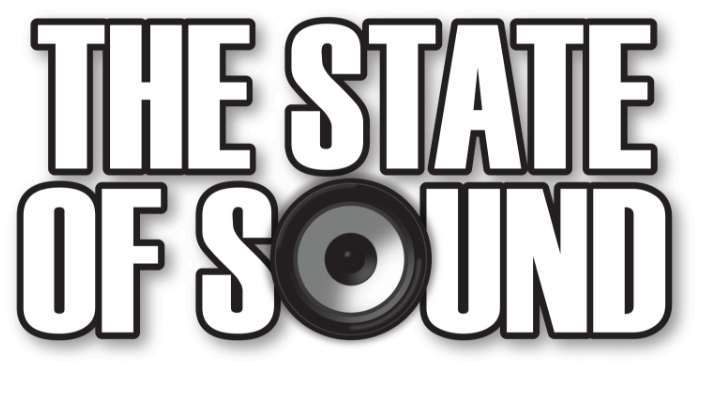
Lorem ipsum dolor sit amet, consectetur adipiscing elit, sed do
eiusmod tempor incididunt ut labore et dolore magna aliqua.
To start your journey: 1) Click on the down arrow 2) Use the scroll bar or 3) Click on
the Table of Contents to view the key topics

The Spirit of Possibility Moves Us
Generations of musicians have come to Illinois by train, bus, and automobile.
The
Land of Lincoln has offered the promise of jobs, housing, and a new way of
looking
at things. Rhythms and lyrics that carried these desires shaped a sound that has
a
global reach. This community of Illinois music reflects our American diversity:
Spiritual and Blues, Country, Soul and Rock, International, and Hip–Hop and
House.
This music helps us imagine who we are. And through the boundless energy of our
imagination, we can reach our potential. In this beautiful hall in the center of
the
country, you will discover how the sound of the heartland lives within all of
us.
You will celebrate who we can be when we sing a song together.
– Dave Hoekstra
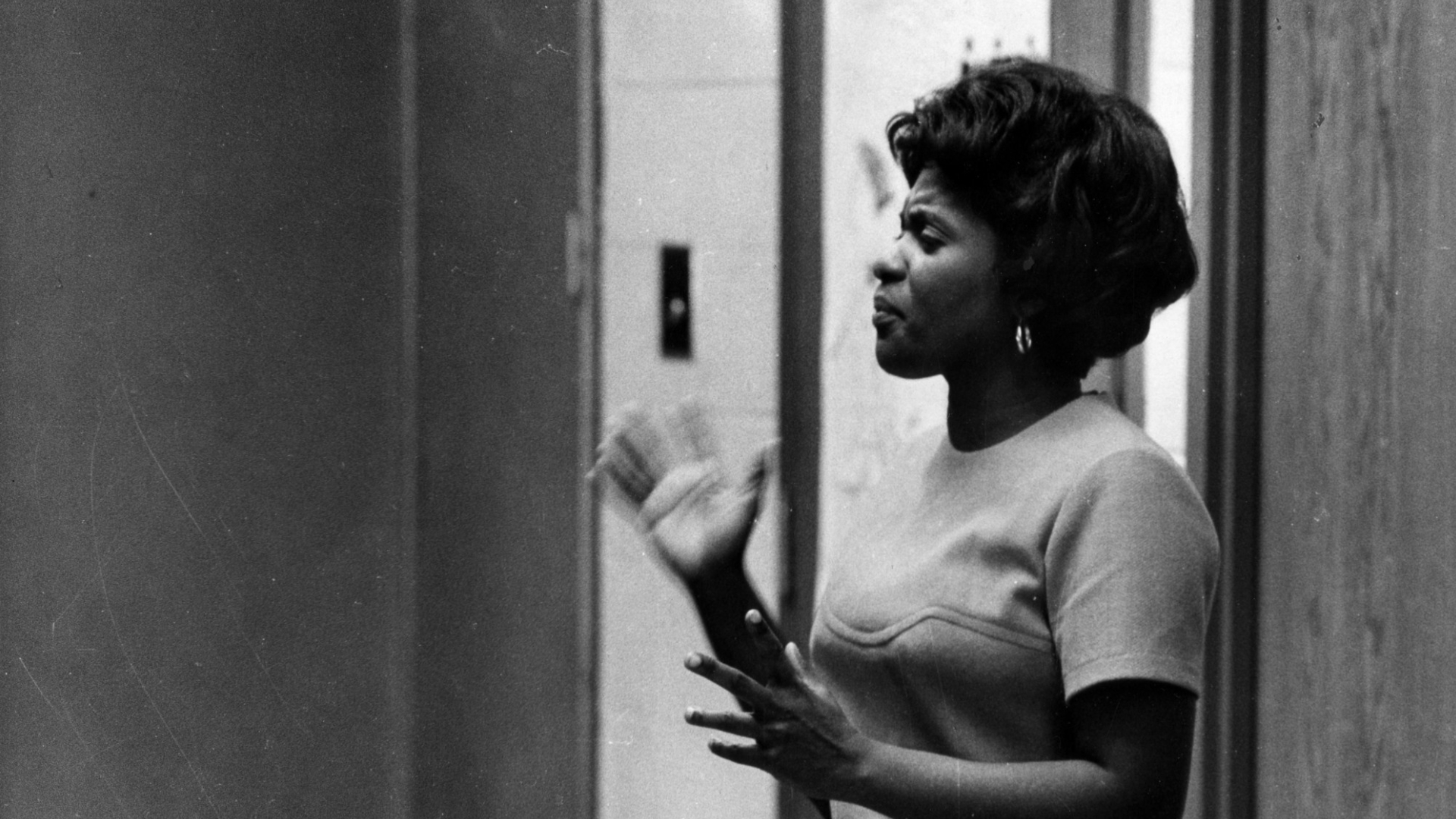
Gospel Music
Gospel Music

Gospel Music
Sound of Higher Ground
The sonic description of Gospel music is a harvest of all that comes from
the heart:
love, pain, memory and hope. The voice is the vessel to deliver the news.
The voice
can be solo or it can shape rainbows in a choir. Like a centerpiece on a
table, this
declaration is surrounded by instrumentation that ranges from an
earth-shaking
guitar to a cresting organ.
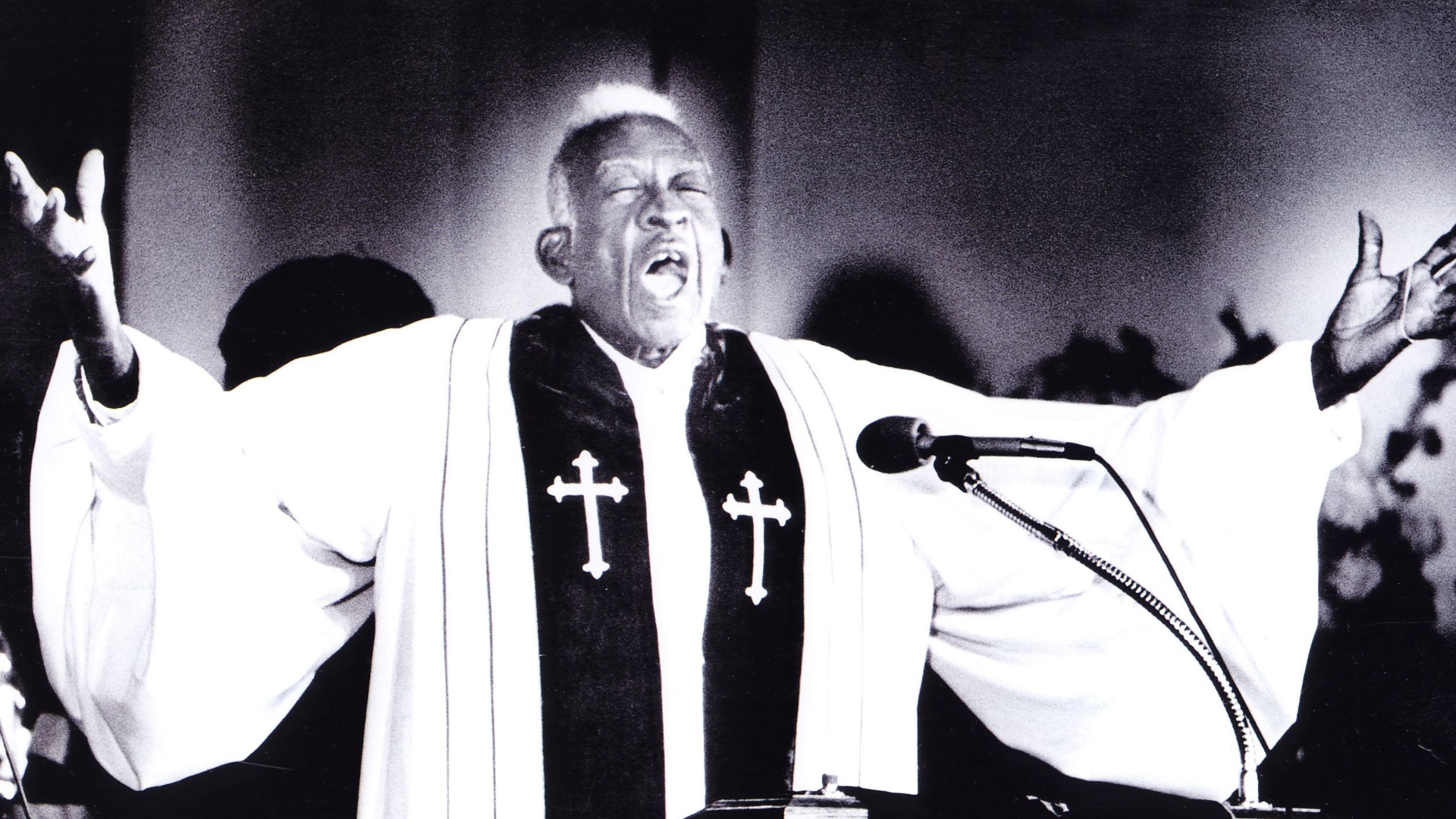
Gospel Music
Sound of Higher Ground
Chicago is the birthplace of American gospel. Chicagoan Thomas A. Dorsey —
"The
Father of Gospel Music" — wrote songs that touched Dr. Martin Luther King
and Elvis
Presley. Chicago's Soul Stirrers illustrated the bridge between gospel and
soul
music with young members like Sam Cooke, Lou Rawls and Johnnie Taylor. The
Gospel
spirit traveled into Chicago area homes from 1963 to 1984 through the
popular
Jubilee Showcase television show.
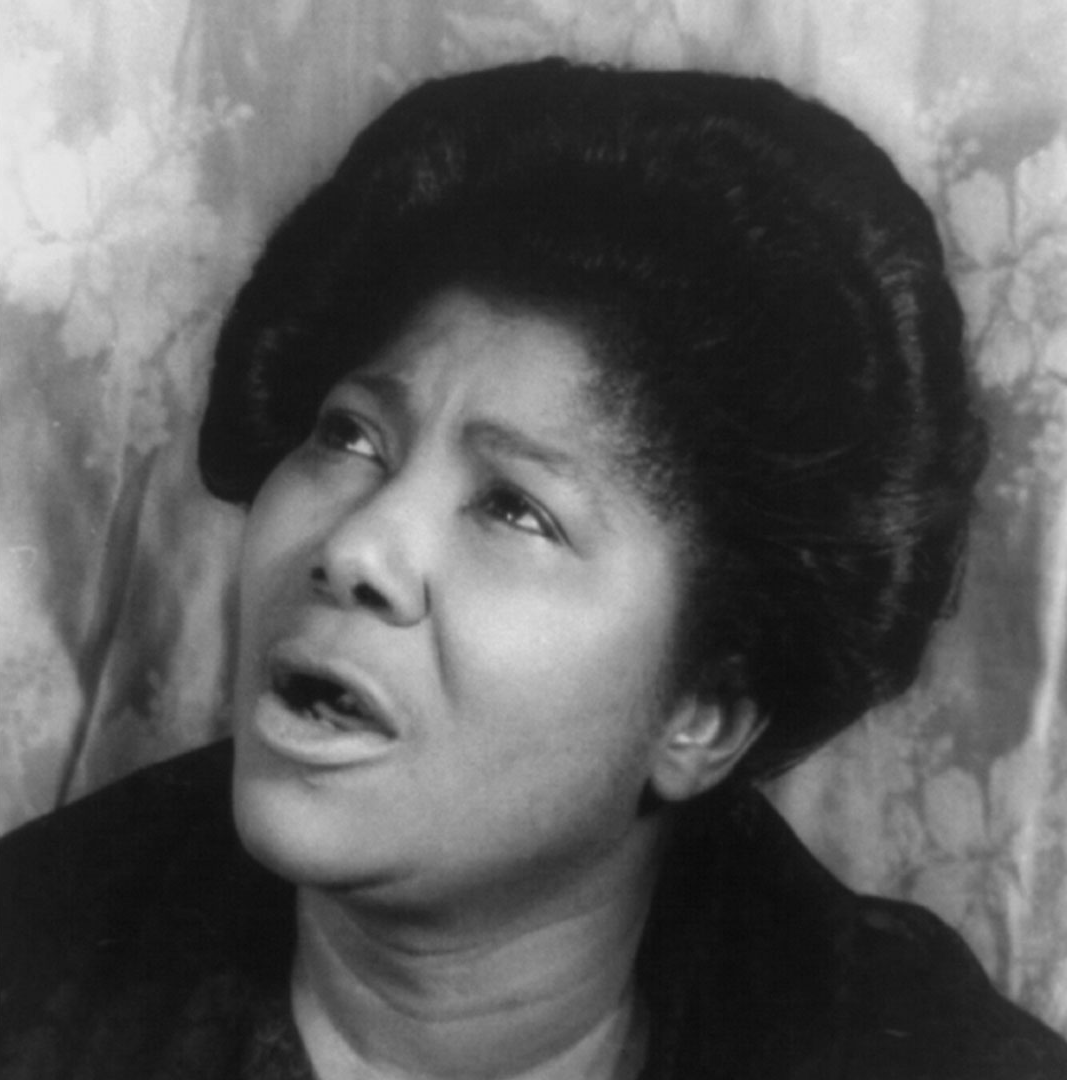
Gospel Music
Title
The Gospel sound is precious and timeless. It bends notes and walks the
mainline.
The most deliberate hymn contains a wide range of expression. All Gospel
music
contains unparalleled devotion.
It celebrates the purity of the soul.
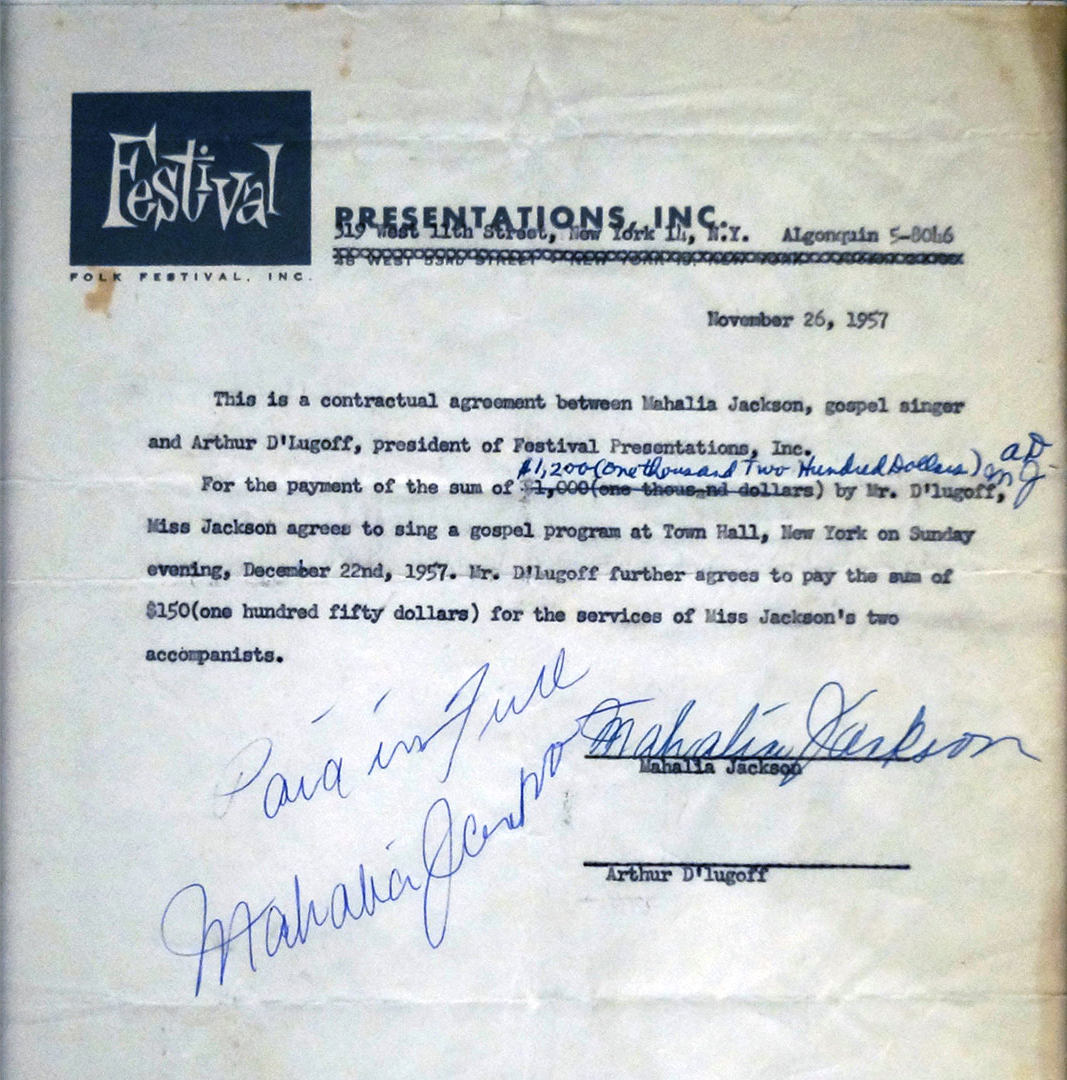
Gospel Music
Mahalia Jackson 1957 Performance
Contract
By 1957, Mahalia Jackson stood at the pinnacle of her career as the
country's top
gospel singer and was now on Columbia Records. This contract to perform at
New York
City's prestigious Town Hall in 1957 provides a glimpse into Jackson's famed
business acumen, as she notes to increase her performance fees.
Courtesy of Robert M. Marovich
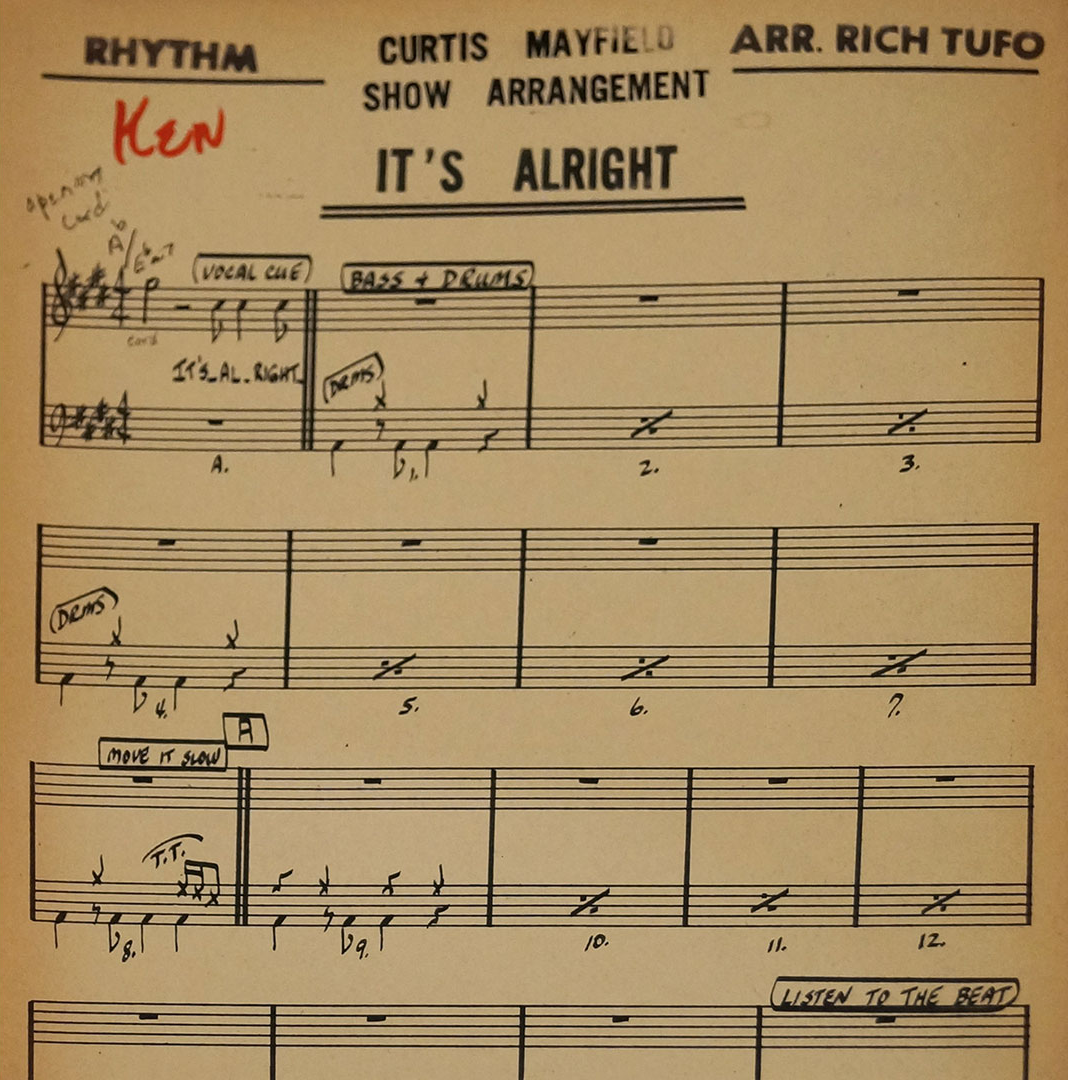
Gospel Music
Curtis Mayfield Performance
Music Score of
"It's Alright"
Curtis Mayfield regularly included his 1963 Impressions hit, "It's
Alright," in his
live shows. This is a marked-up performance "Rhythm" score for the song,
which has
been covered by Etta James, Phil Collins, Huey Lewis, Bruce Springsteen,
and was
recently featured in the Disney movie Soul.
Courtesy of the Curtis Mayfield Estate
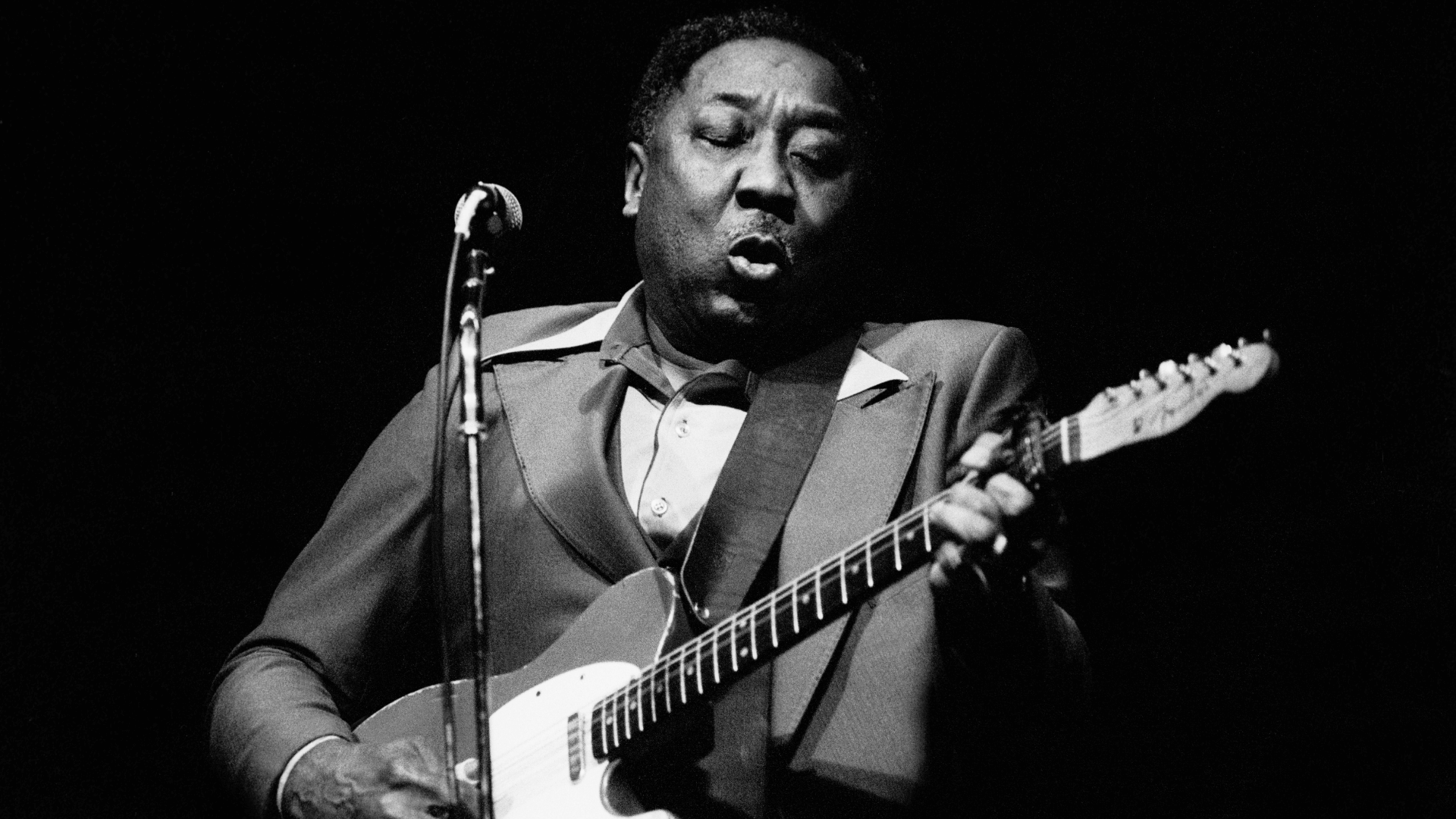
The Blues
The Blues Grew into its Wings in Illinois
The blues are a sparrow that flew north over the Mississippi
River and landed in
Illinois.
Out of the nest came the electricity of Muddy Waters and the
haunting call of
Howlin' Wolf. Waters (McKinley Morganfield) carried the muscle
of mother earth while
Wolf (Chester Burnett) was possessed by a wicked bolt of
"Smokestack Lightning."
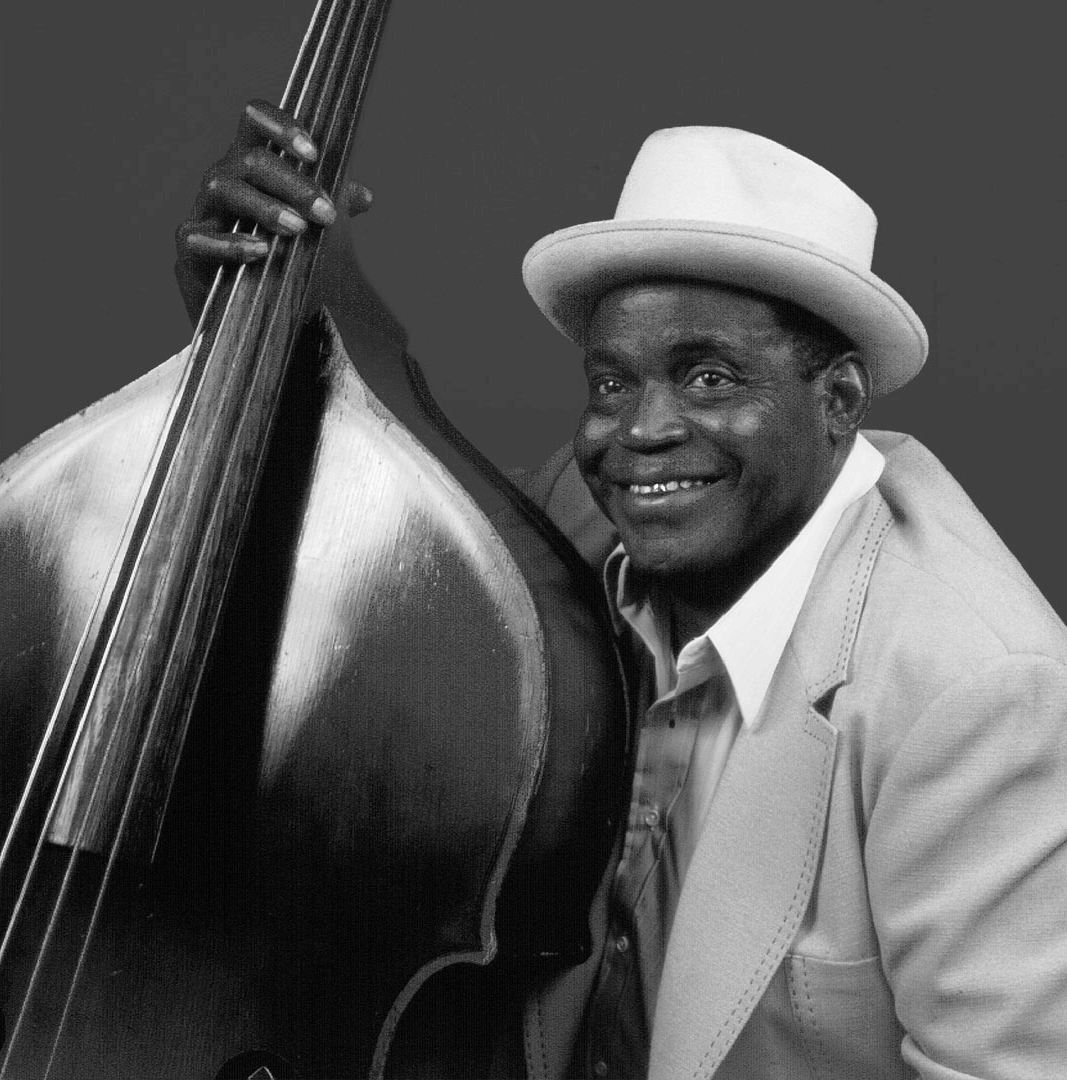
The Blues
Title
Chicago bandleader, songwriter, and bassist Willie Dixon
dispatched his profound
rhythms across the world. Dixon's sound was a passport to rock
n' roll. Led Zeppelin
never would have had "Whole Lotta Love" without Dixon's "You
Need Love." Dixon was
also an early architect at Chess Records before flying off to
Chicago's Cobra
Records in the late 1950s where he produced nascent tracks for
Buddy Guy, Otis
Rush, and Magic Sam.
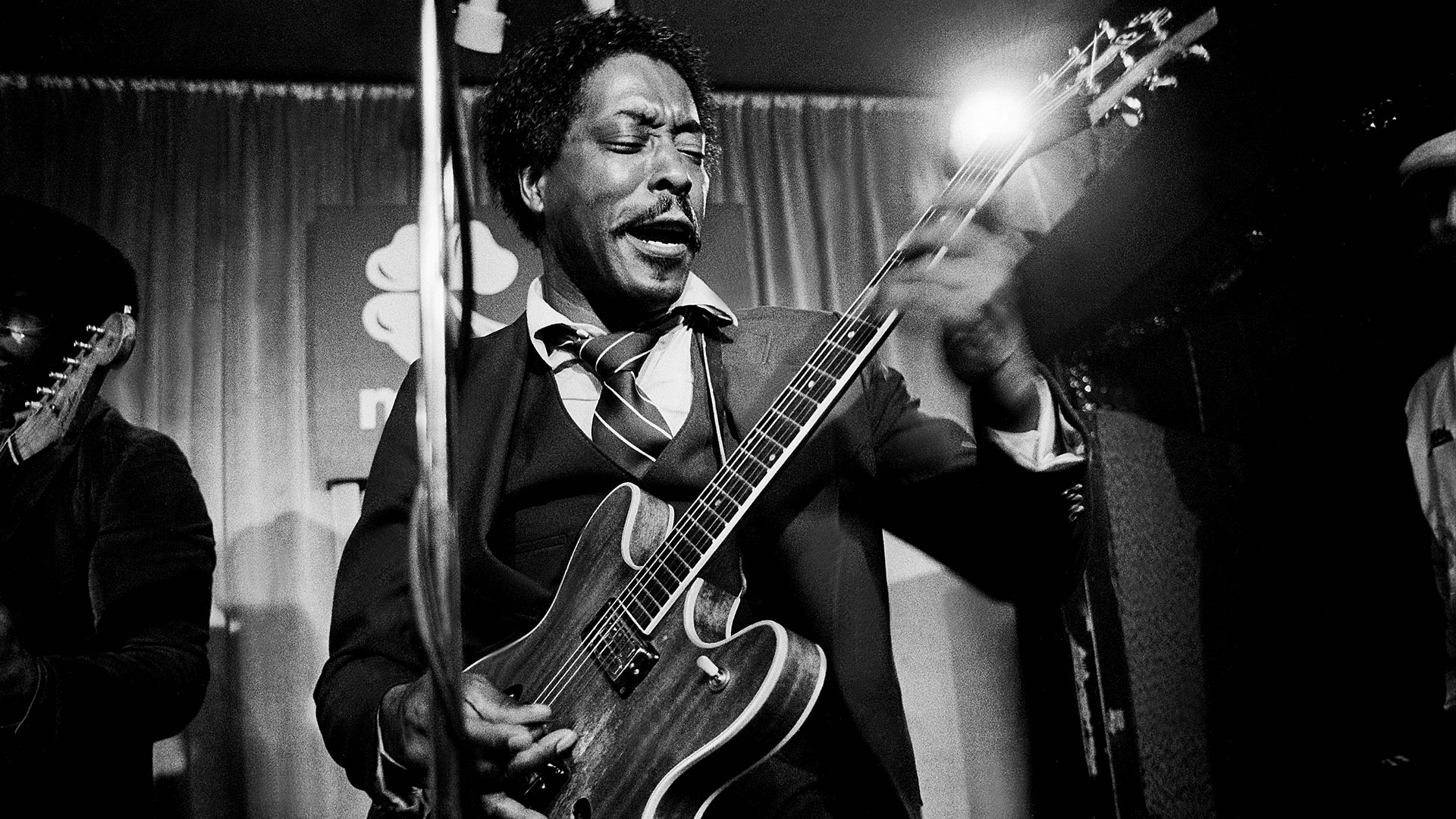
The Blues
Sound of Higher Ground
Buddy Guy's electricity and business acumen delivered the blues
to a new generation
while the Chicago-based record labels Alligator and Delmark
Records preserved the
blues for the future. The earliest recordings of boogie
guitarist Hound Dog Taylor
at Alligator (1971) and nine-string guitarist Big Joe Williams
(in 1961) at Delmark
kept the blues pumping through the advent of pop and rock music.

The Blues
Fender Stratocaster Guitar Owned and
Played by Buddy Guy
Buddy Guy's electricity and business acumen delivered the blues
to a new generation
while the Chicago-based record labels Alligator and Delmark
Records preserved the
blues for the future. The earliest recordings of boogie
guitarist Hound Dog Taylor
at Alligator (1971) and nine-string guitarist Big Joe Williams
(in 1961) at Delmark
kept the blues pumping through the advent of pop and rock music.
Courtesy of Buddy Guy's Legends
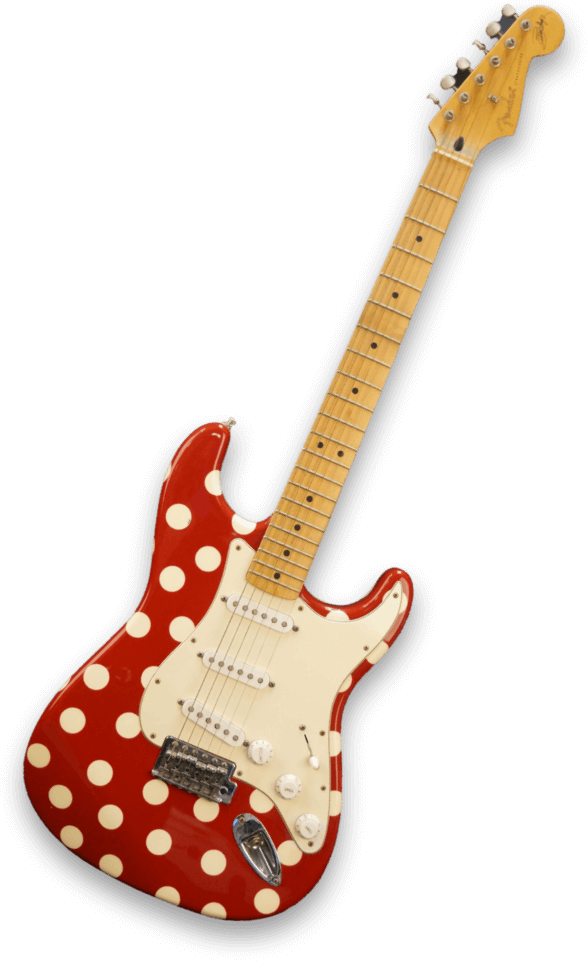
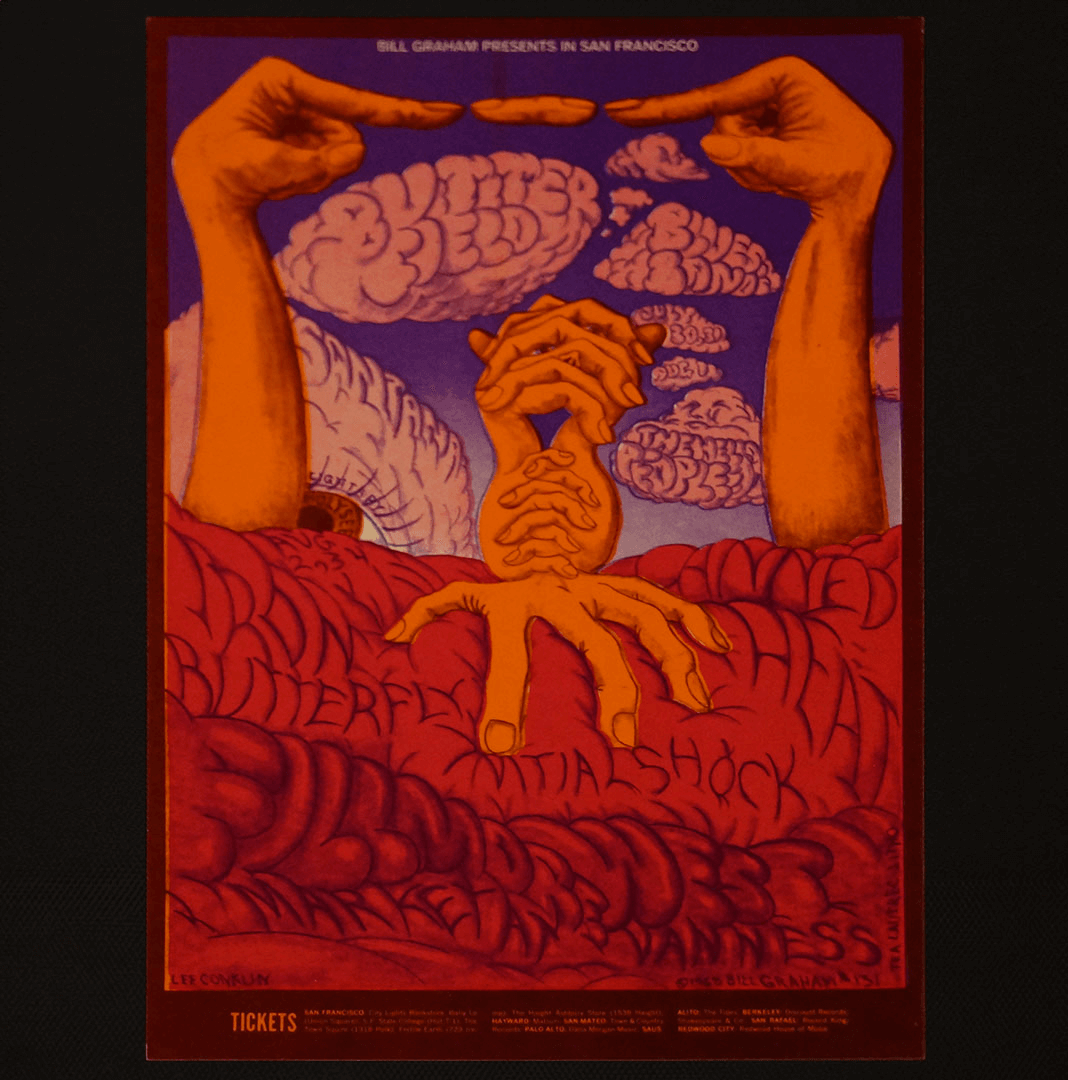
Music Poster
Mahalia Jackson 1957
Performance Contract
Lorem ipsum dolor sit amet, consectetur adipiscing elit, sed do
eiusmod tempor
incididunt ut labore et dolore magna aliqua. Non diam phasellus
vestibulum lorem.
Lorem mollis aliquam ut porttitor leo a diam. Quis commodo odio
aenean sed
adipiscing diam donec adipiscing tristique. Aliquet enim tortor
at auctor urna.
Courtesy of Robert M. Marovich
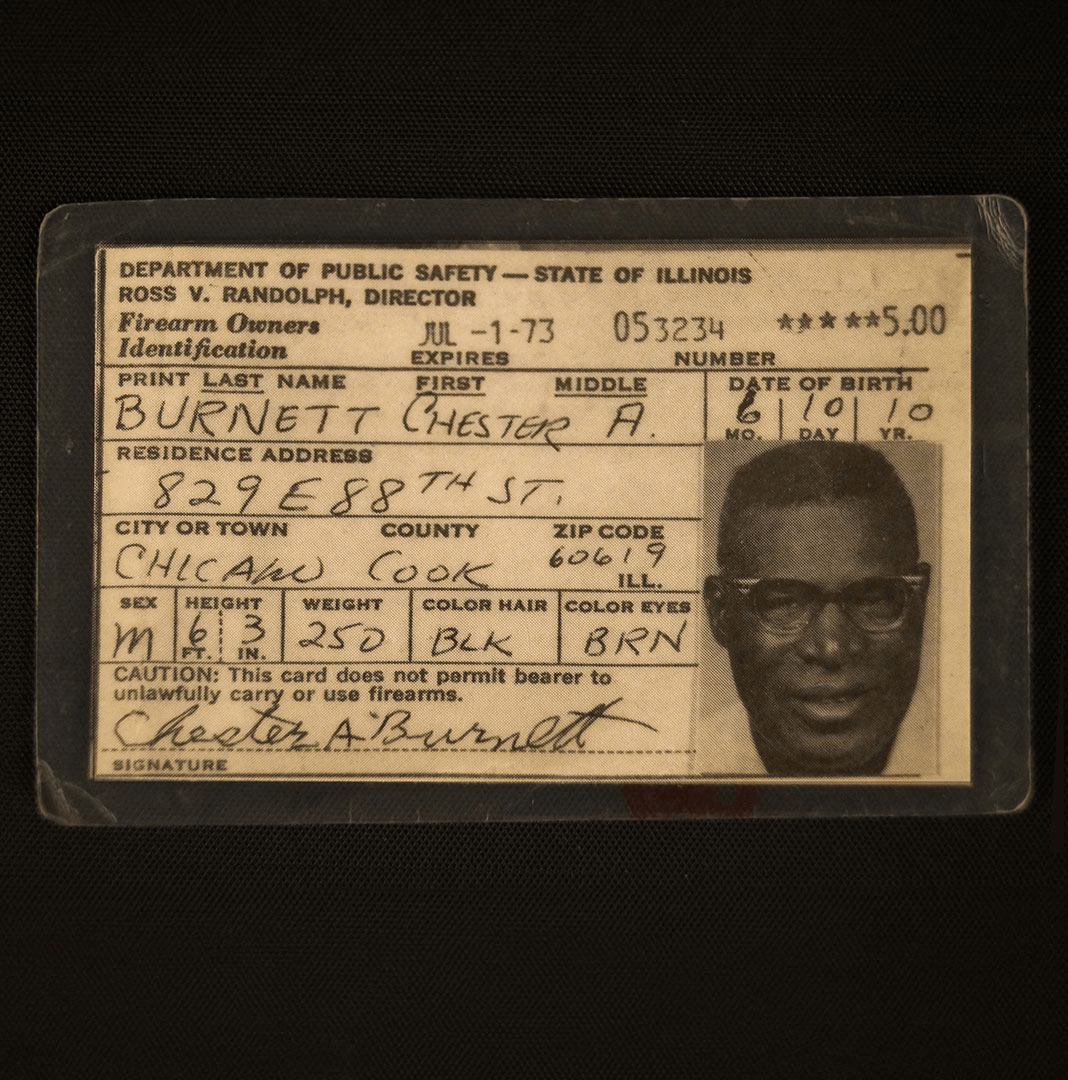
The
Blues
Howlin' Wolf's
Personal Effects
Howlin' Wolf (Chester Burnett) had a big striking voice and
was also an imposing
figure at 6 foot 3. He carried a firearm for protection, for
which he needed this
1960s-era firearms license. Also featured is his personal
shaving brush with a
wooden handle, a common item for someone born in 1910.
Courtesy of Bettye Kelly